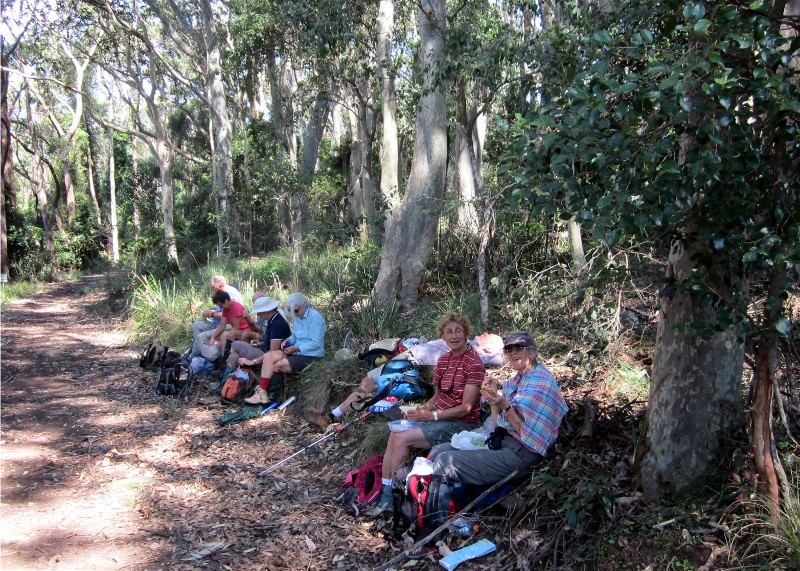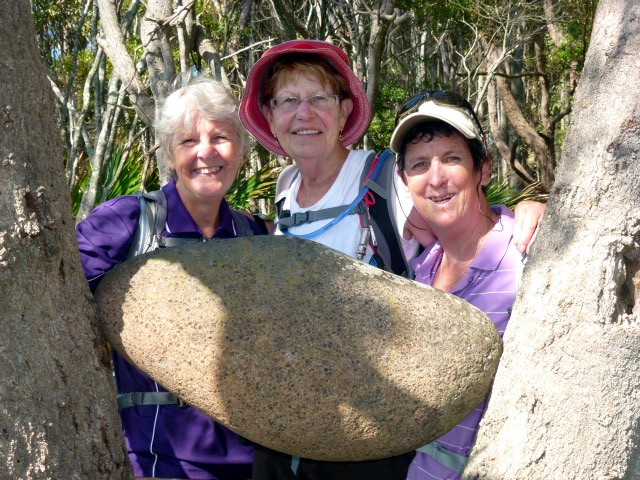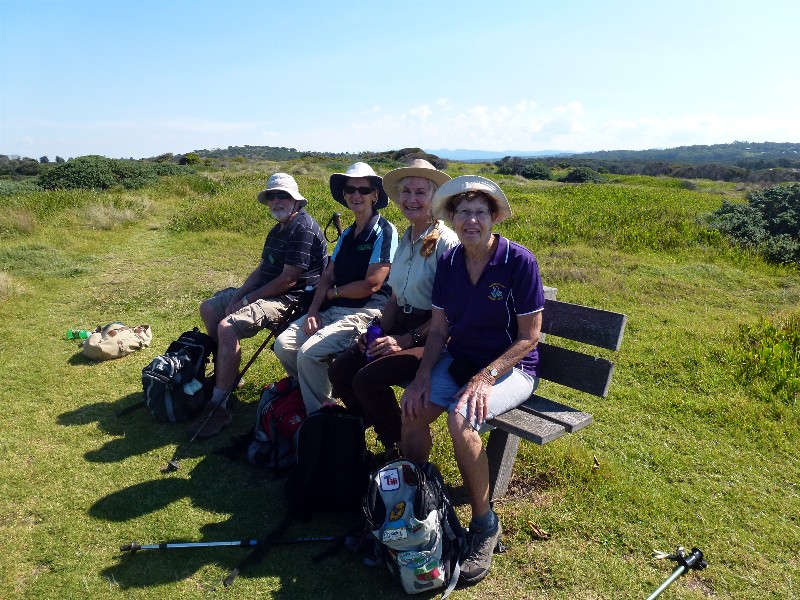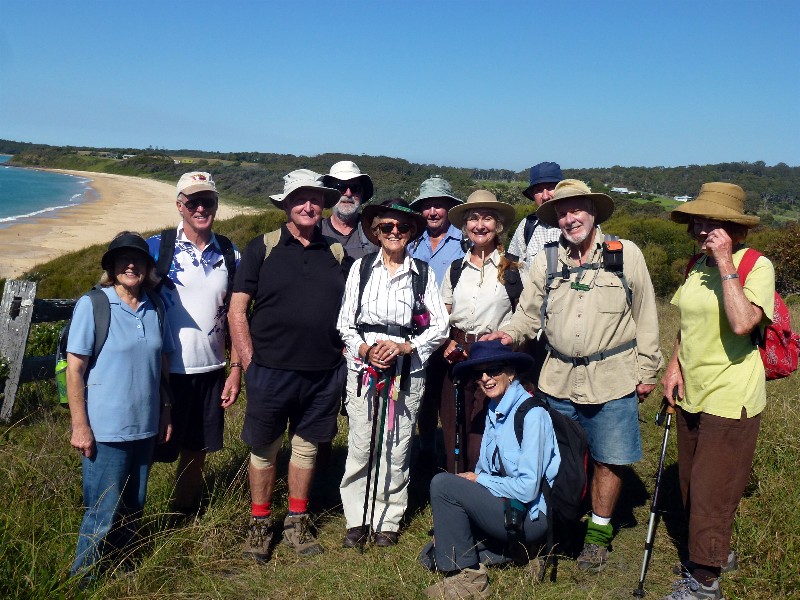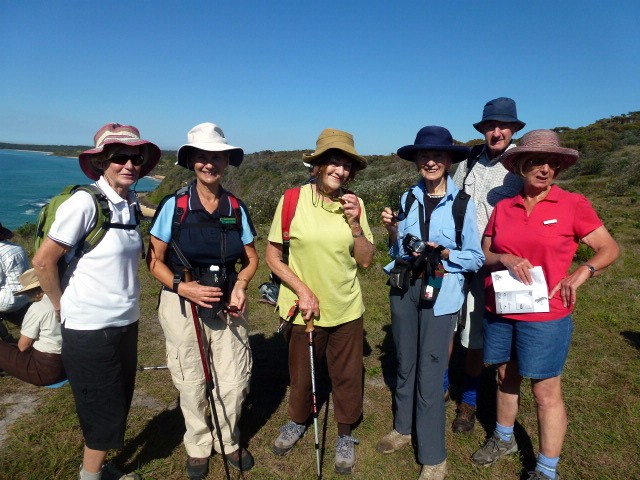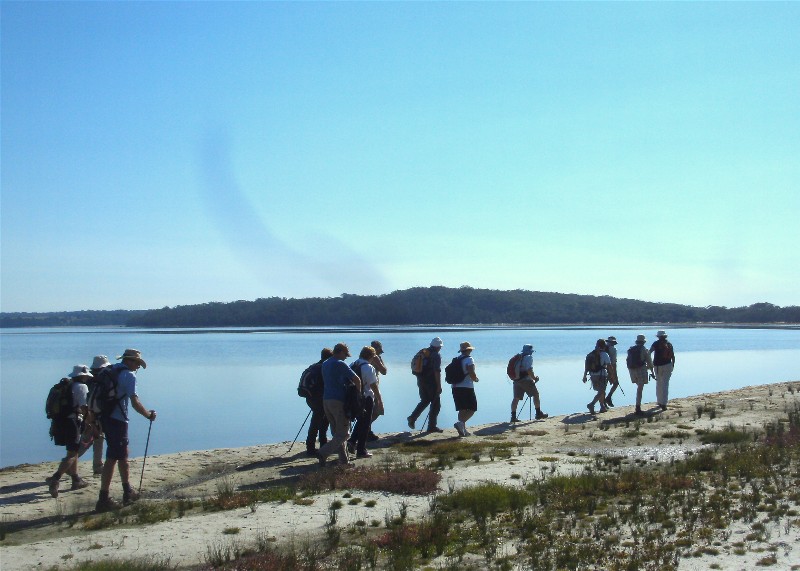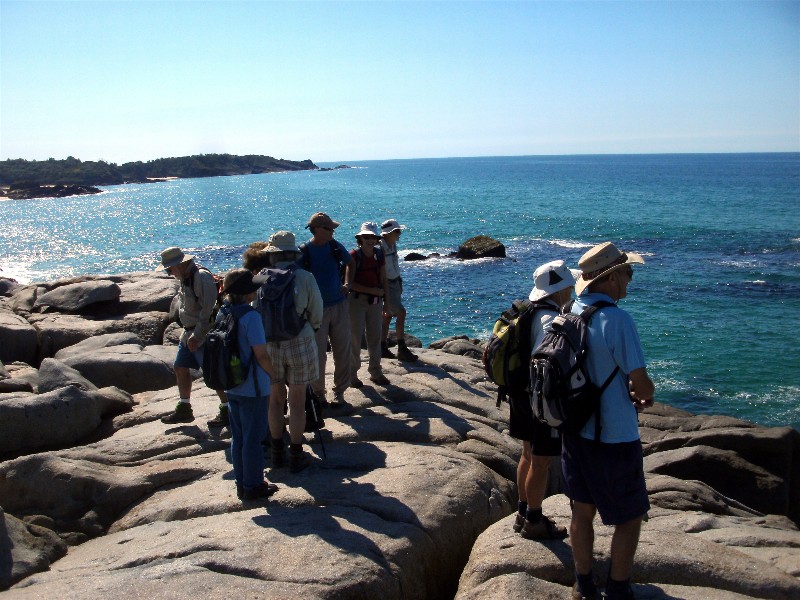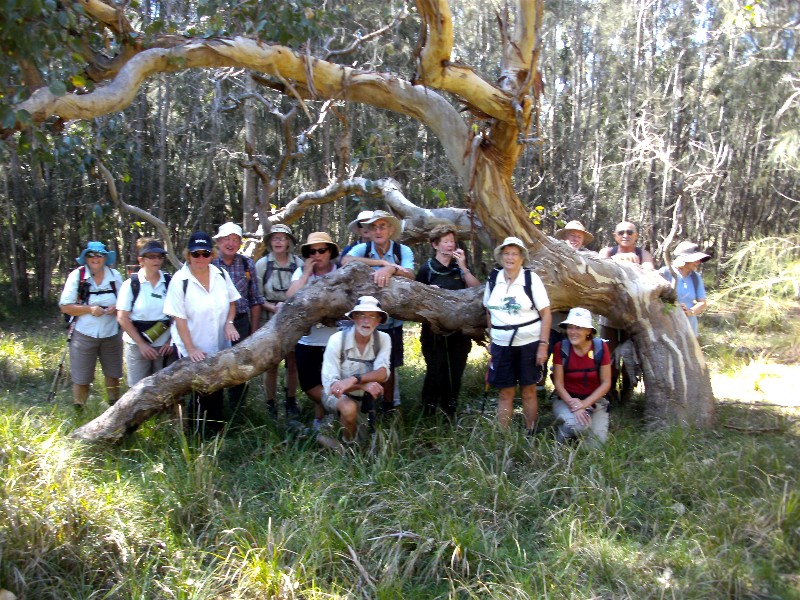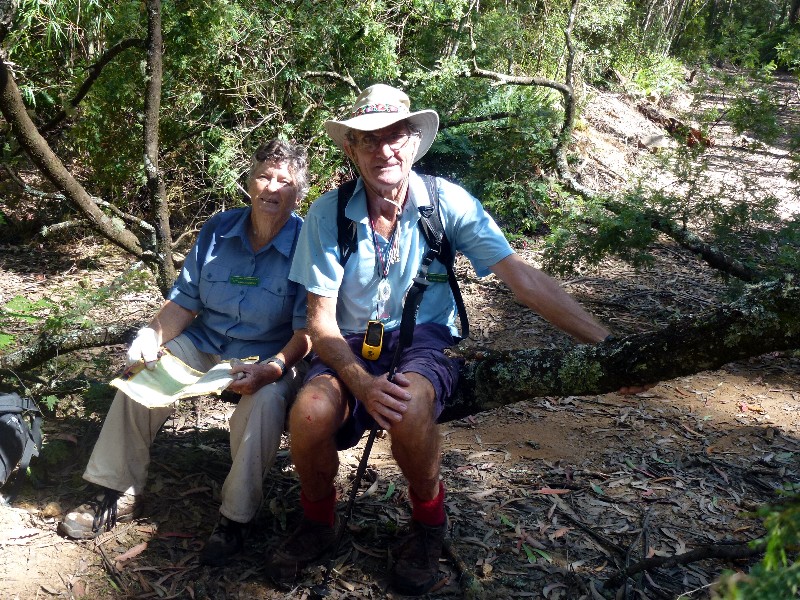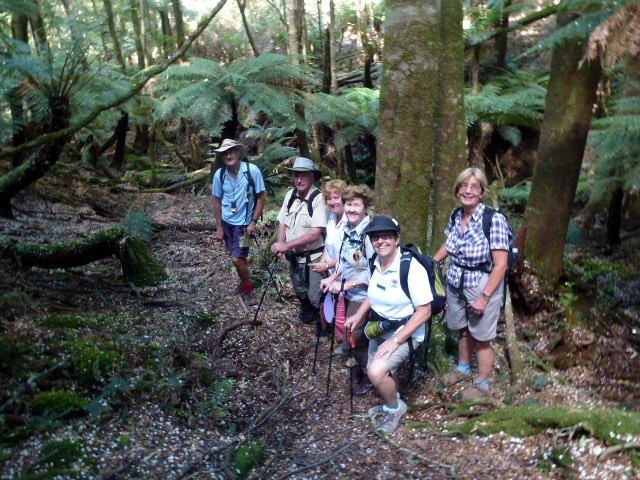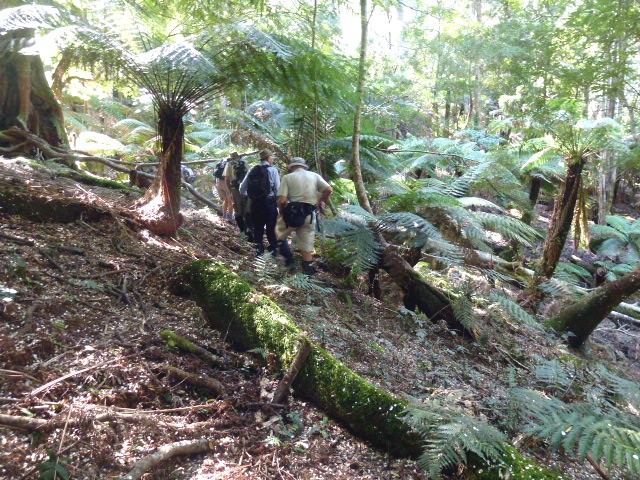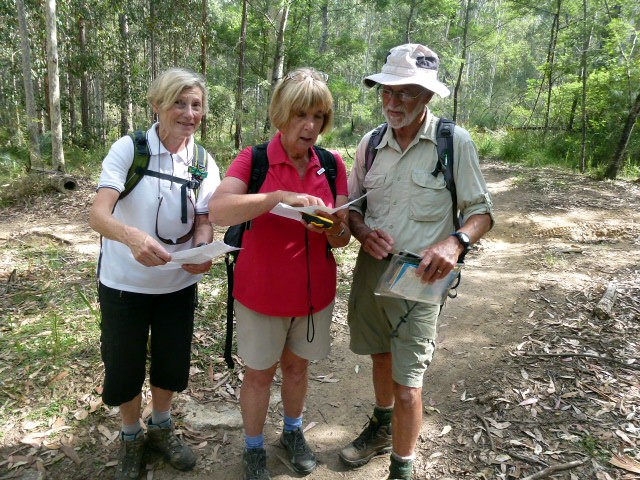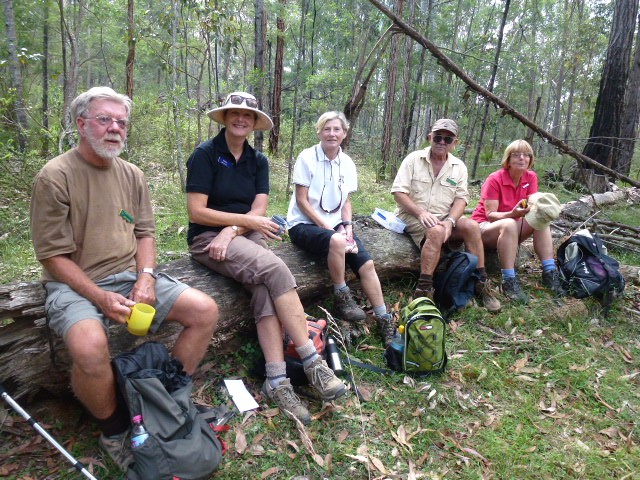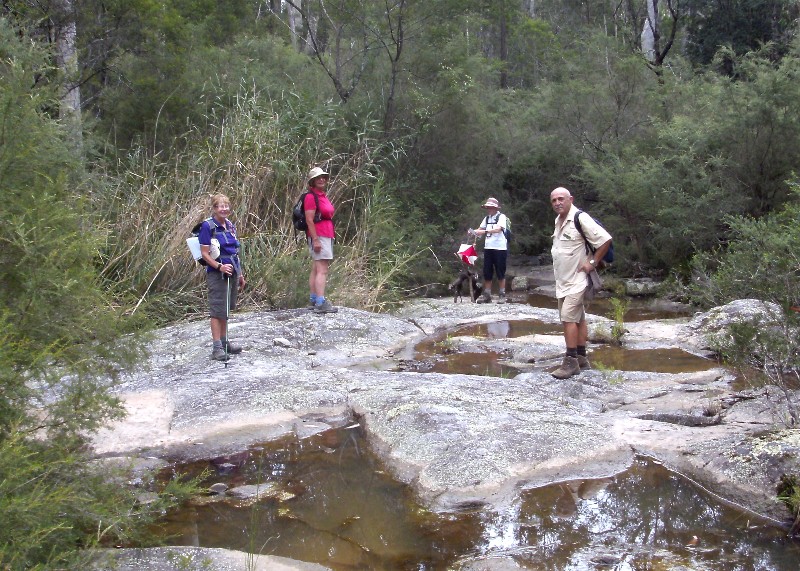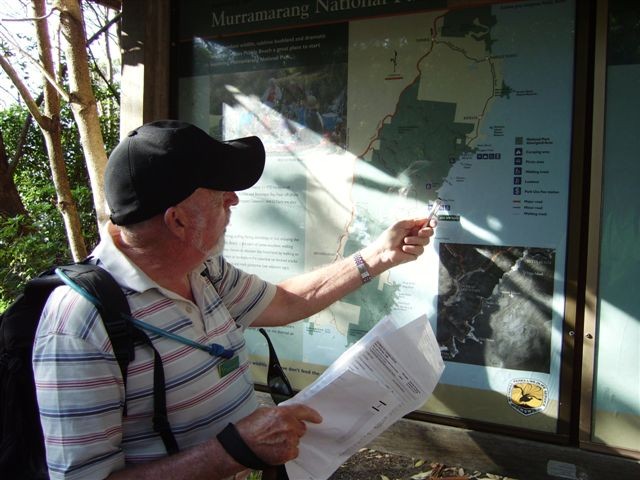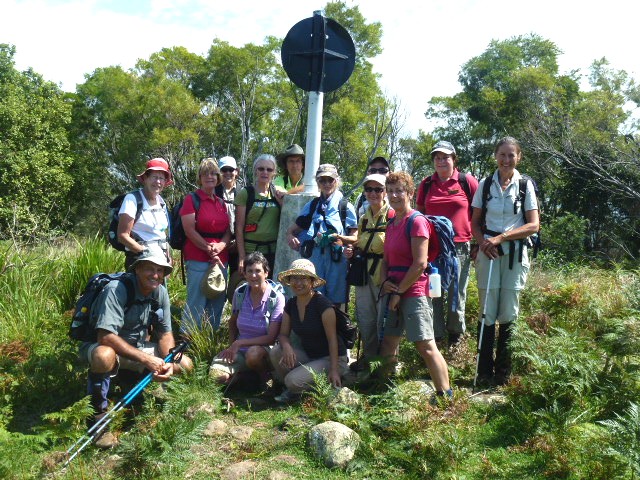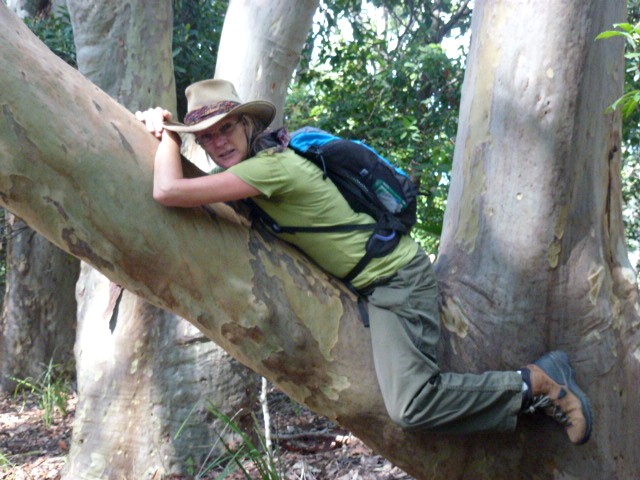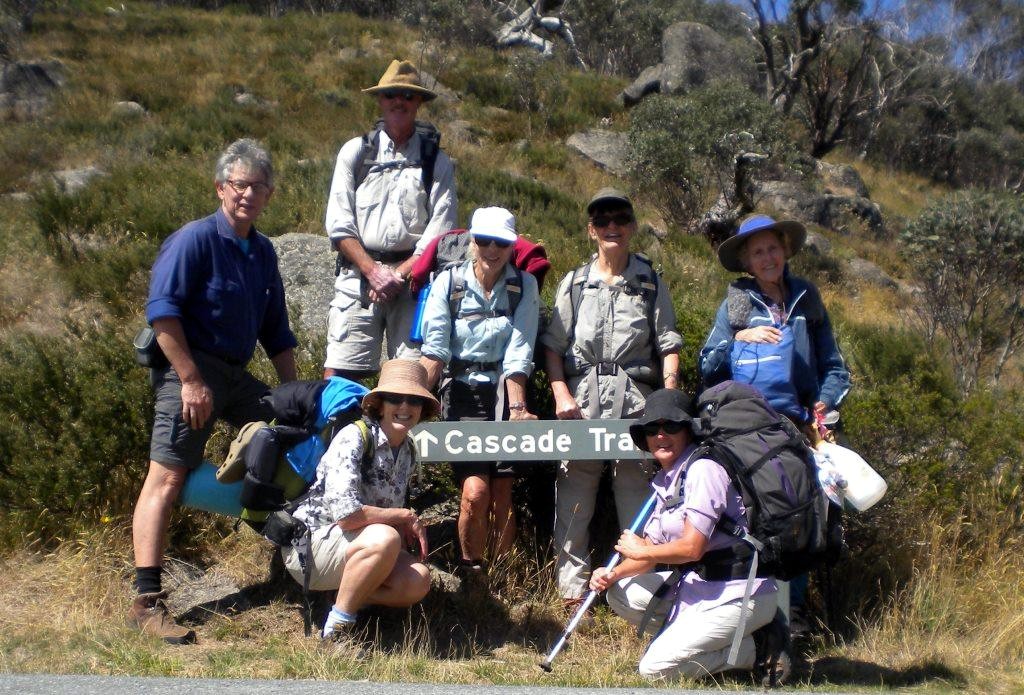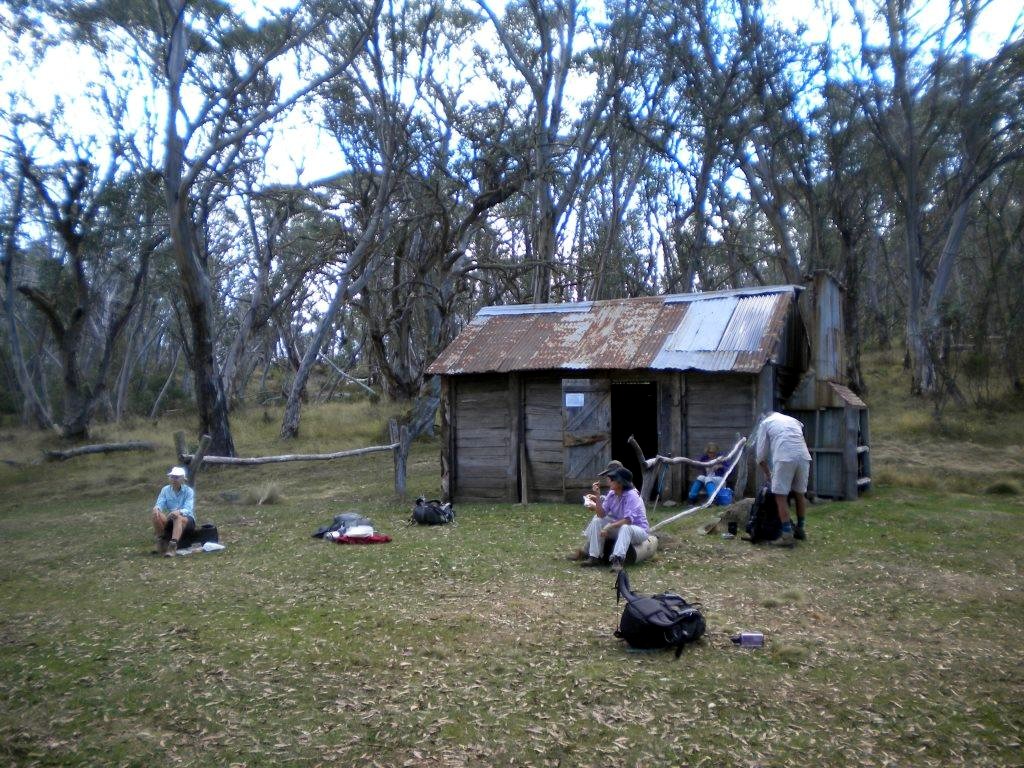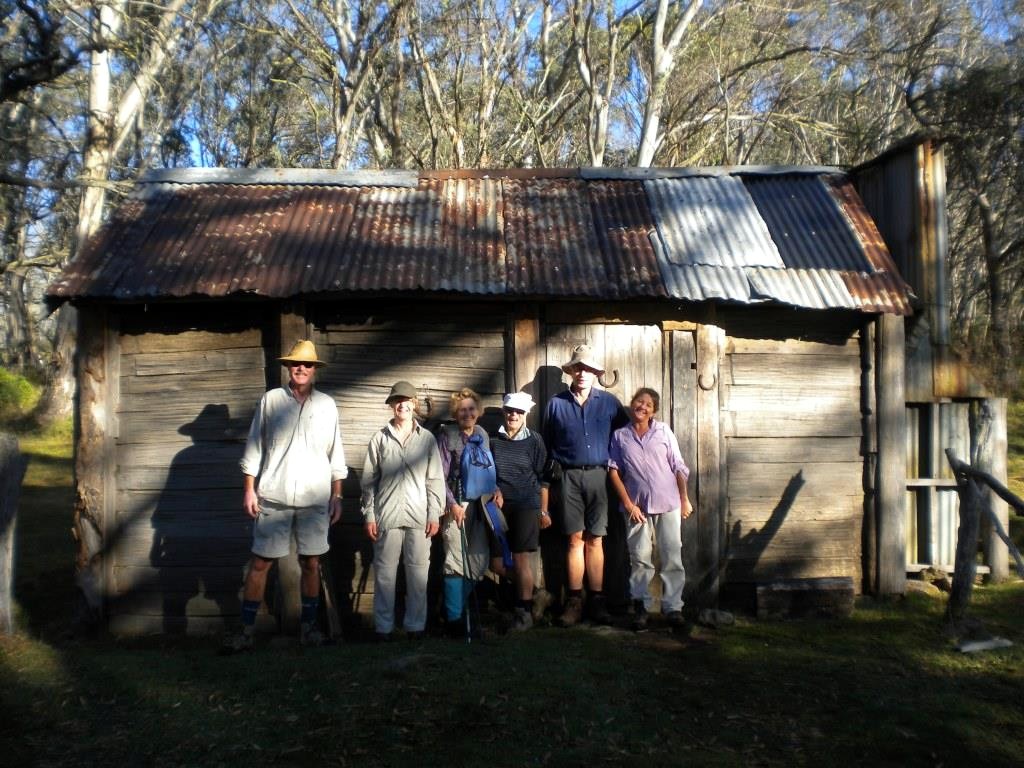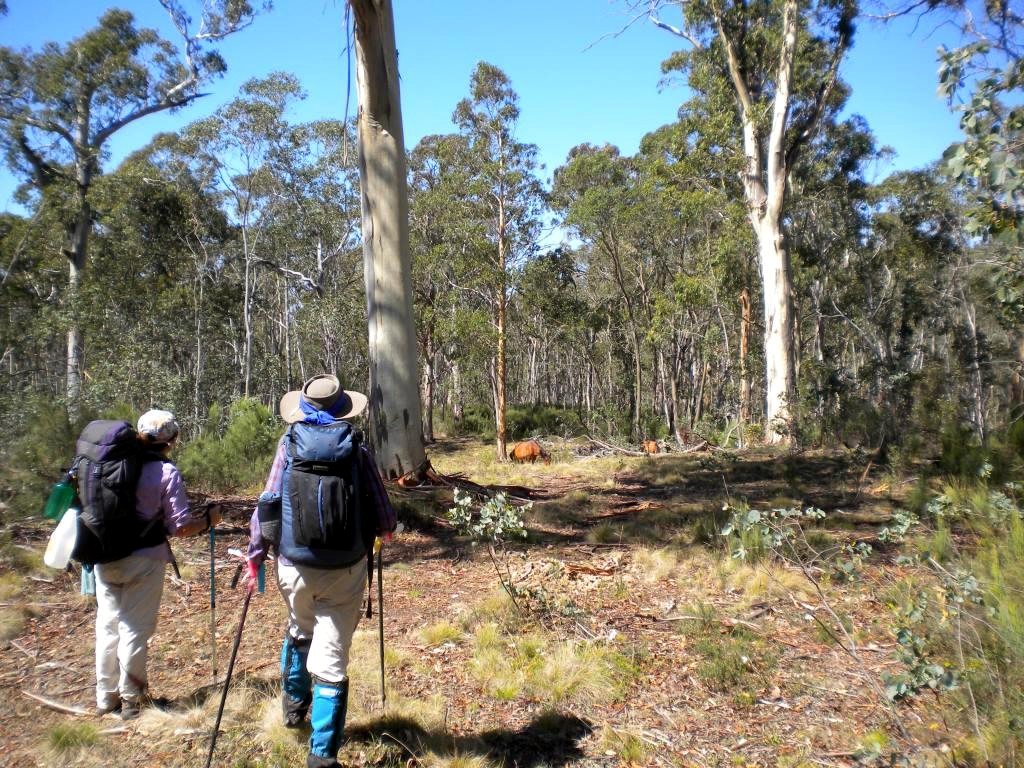 |
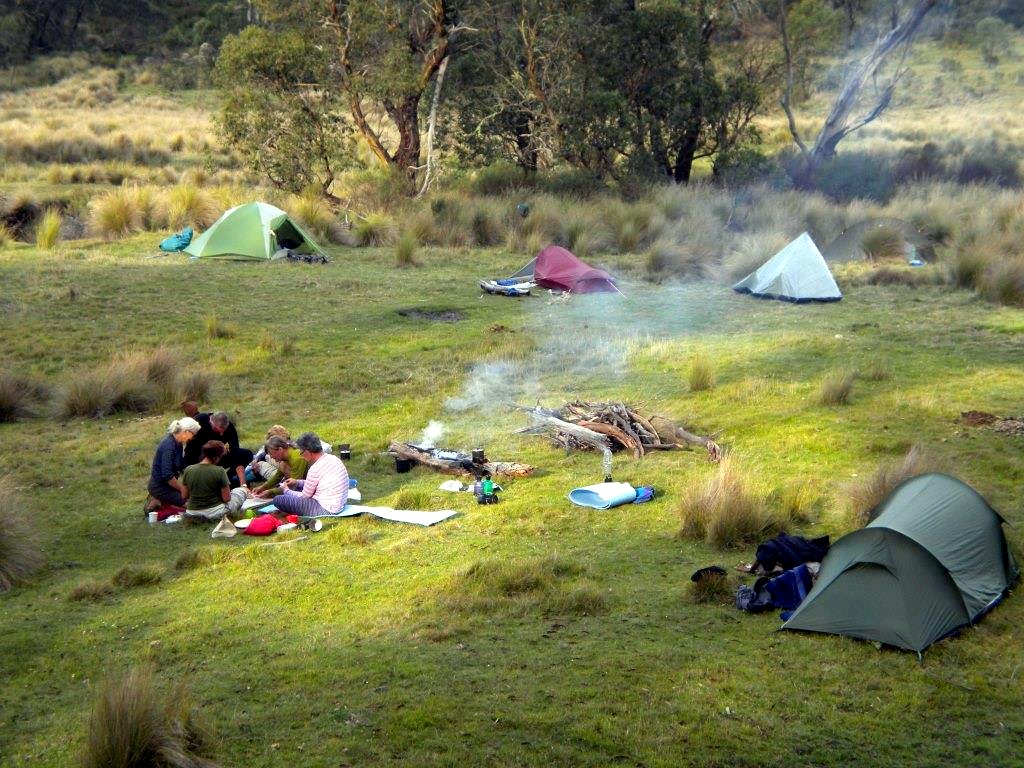 |
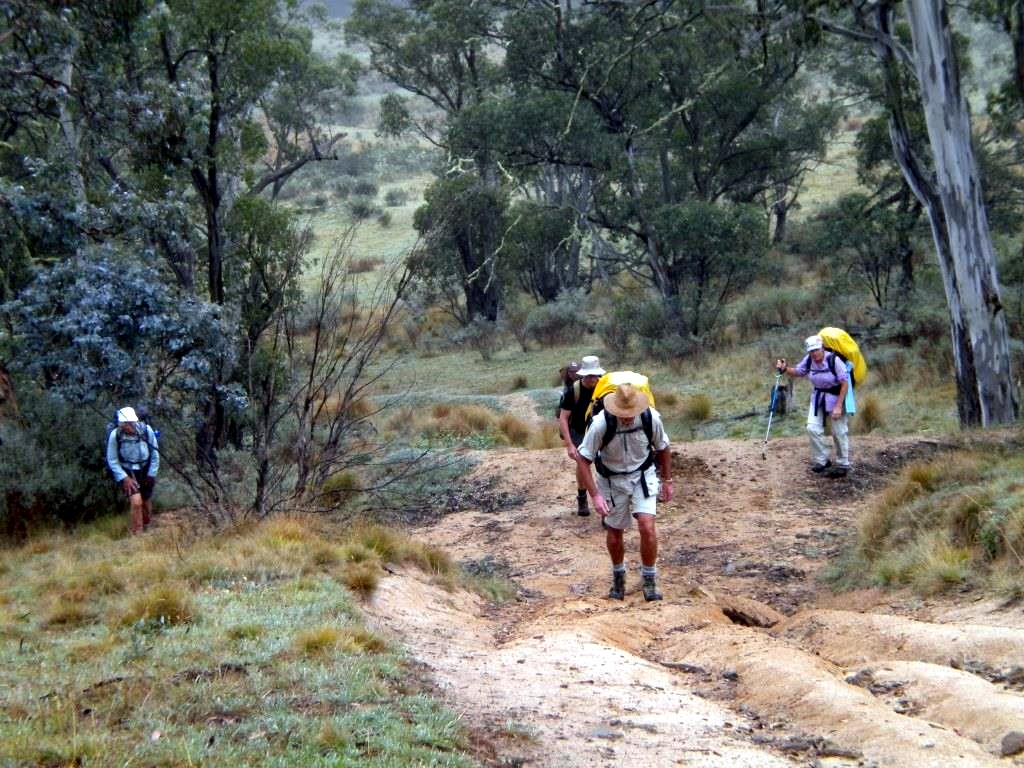 |
Betty and Wendy pause for brumby watching
Photo by Ian
Click on thumbnail to enlarge photo |
Serious card game at Ingeegoodbee River camp
Photo by Ian
Click on thumbnail to enlarge photo |
Rudy leads a rare uphill climb
Photo by Ian
Click on thumbnail to enlarge photo |
The Pilot Wilderness is a large 92,400 hectare slab of Kosciusko National
Park between Thredbo and the Victorian border. It contains the NSW southern
extent of the Great Dividing Range, including The Pilot mountain of 1,829
metres asl and the source of the mighty Murray River.
The topography and vegetation varies greatly with altitude. The sub alpine
plateaus of snow gum, alpine ash and snow grass quickly plunge up to 1,000
metres into the Murray River to the west and the Jacobs, Pinch and Ingeegoodbee
Rivers to the east, themselves tributaries of the Snowy River where dry
peppermints, boxes, stringybarks and black cypress pine dominate.
Seven club members – Rudy, Wendy, Betty, Bronwyn, Sharon, Lin and Ian
crossed this wilderness north to south from Dead Horse Gap on the Alpine Way
to the Pinch River camping area on the Barry Way via The Tin Mines. Rudy
organised his Jindabyne mates to look after the 300 km car shuffle which was a
big relief because it allowed us about 6 hours more walking.
Apart from a few blisters the distance of 52 kilometres was covered in four
days of relatively easy and open trail walking. The sub alpine frost hollows
and woodlands were particularly enjoyable. The extensive 2003 fire killed
forests south of Dead Horse Gap to Tin Mines were a sea of dead trees and thick
regrowth, only a portion of the Australian Alps so treated over the last
decade and a salient reminder of probably one of Australia’s greatest
environmental events.
On the first night at Cascade Hut most of us tented under the snow gums and
similarly on the second night at Carters Hut (Tin Mines). The third night on
the banks of the Ingeegoodbee River near the Freebody Hut site was on snow
grass under the stars. Every site was a picture postcard perfect camp site and
most worthy of relaxation after each day’s walk. The water temperature in the
nearby creek was, on each occasion, bearable for a quick bath.
On day two we left the track in search of the nearby Tin Mine Falls,
supposedly the highest in Kosciusko NP, but the thick fire regrowth beat us.
Notably, over four days, Sharon found three cameras, all remarkably the same
make and model as her own!
The descent of the plateau from the elevated Ingeegoodbee River to Pinch
River down the Nine Mile Trail was steep and littered with loose gravel.
Progress was slow and the thigh muscles bulged. The change in vegetation
from cool, moist sub alpine frost hollow to steep, dry, open woodland in only
a few kilometres was remarkable.
Along the route we saw only two other people in the four days, mountain
bikers, but unfortunately horses were numerous and the route was littered, and
stank, of horse shit. We startled a pair of emus in the Pinch River. I think
the snake count was five – the head of the conga line changed at each sighting!
Ian
back to Top
Potato Point to Tuross Lake
Sunday 10 March 2013
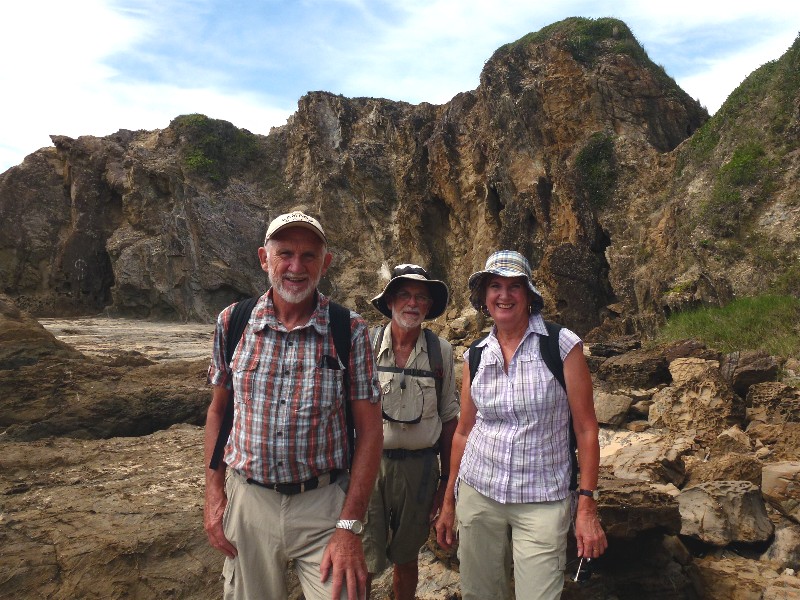 |
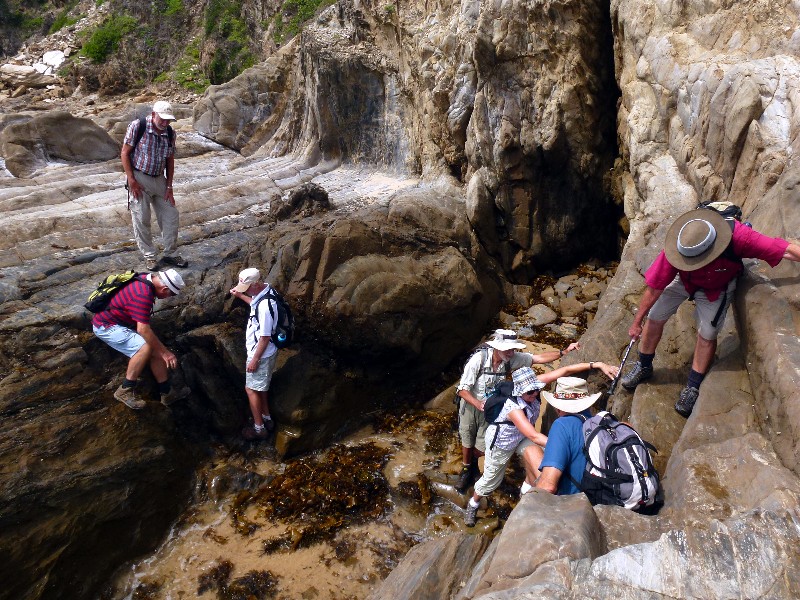 |
John, Stan and Liz
Photo by Lesley
Click on thumbnail to enlarge photo |
Rock scrambling
Photo by Lesley
Click on thumbnail to enlarge photo |
The weather had been perfect all week and Sunday was to be no different. The
skies remained blue throughout our walk, and the sea a beautiful shade of aqua
marine. Walking along the beach could not have been better for our group of 27
walkers. It was an easy–medium walk along nice firm sand, until we reached the
headland at Blackfellows Point. The group could choose a scramble across the
rocks or an easier option up along the cliff tops. There was one tricky bit of
the rock scramble for some to remember as a challenge, with a gap in the rock
shelf requiring a descent into the shallows of some incoming water, and a body
weight heave back up again.
The group reassembled and we continued on to Tuross. A tick removal procedure
halted us for a while, with lively discussion of the pros and cons of different
removal measures. We then skirted inland along the left hand bank of the lake.
Emu tracks were visible in the muddy sand. Prospective fisherman were pumping
sand holes to extract nippers which they were glad to display to some of us who
had not seen them before (we had two overseas visitors with us for the day).
Just prior to our arrival at our lunch spot, the probable makers of the
footprints in the mud, two large emus, were in front of us on the track. They
moved off into the bush on our approach- thank goodness!
Following lunch we proceeded back towards the cars. This time we mostly
followed back along the unmade cliff top road which offered more beautiful ocean
views. John and Jill, definitely a walk worth future repetition- thank you.
Kay
back to Top
Crazy Whist Card Game and Dinner
Saturday 9 March 2013
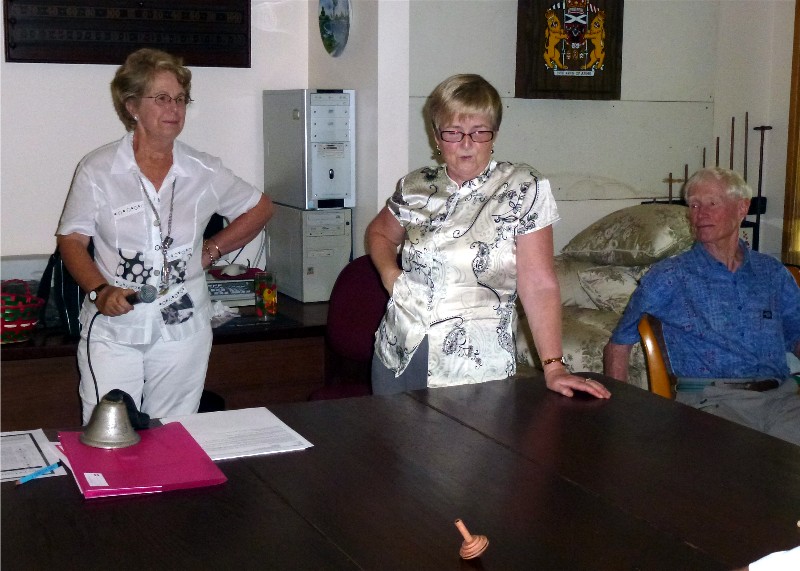 |
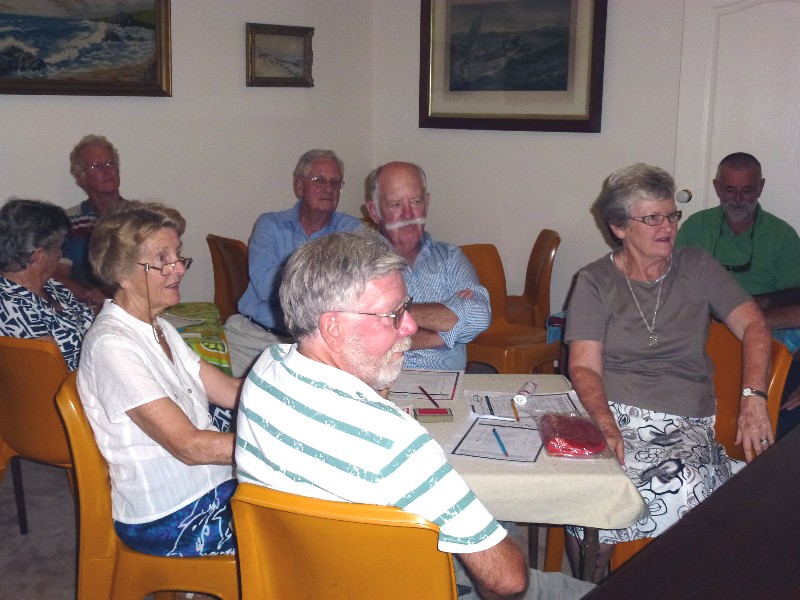 |
Comperes Lyn and Kay
Photo by Lesley
Click on thumbnail to enlarge photo |
Some of the players
Photo by Lesley
Click on thumbnail to enlarge photo |
The social event for this Program was an afternoon of Crazy Whist followed
by supper. Many thanks must go to Ann & Marle, and their son
Charles for opening their home for us, also for all the work they did to accommodate
over 40 members for cards and dinner.
Lyn was our very competent Crazy Whist compere, and Kay and her Social Committee oversaw
all the arrangements. The afternoon finished with the sort of scrumptious meal which
can only come from everyone bringing a plate of their signature dishes.
Lesley
back to Top
Malua Bay to Mosquito Bay Return
Thursday 7 March 2013
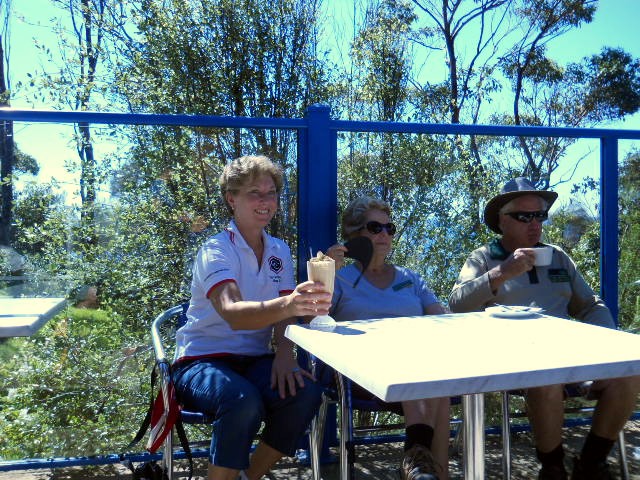 |
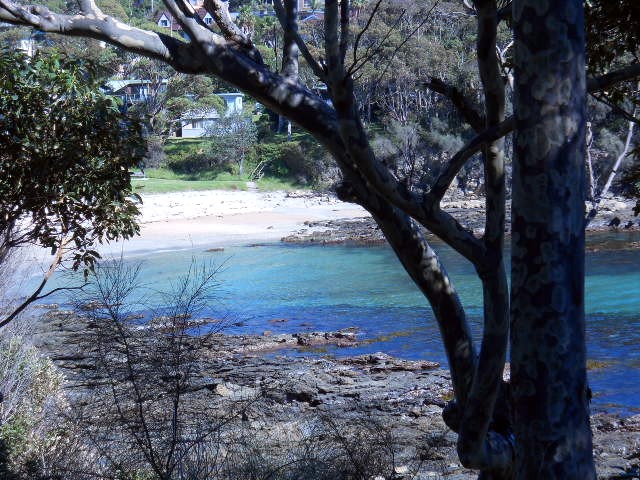 |
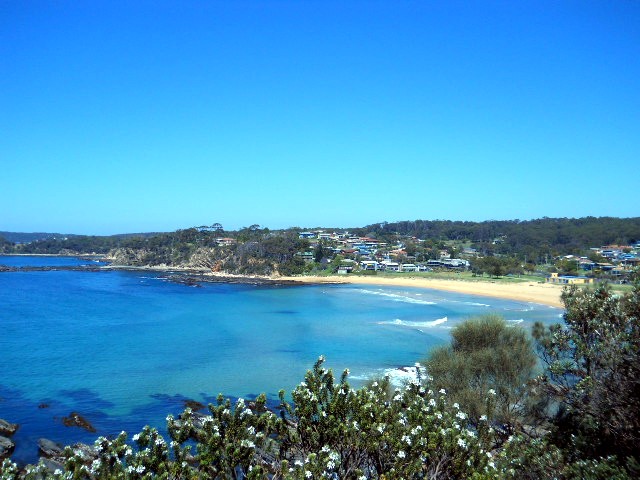 |
Roughing it at Mosquito Bay Cafe
Photo by Janelle
Click on thumbnail to enlarge photo |
Approaching Garden Bay
Photo by Janelle
Click on thumbnail to enlarge photo |
Malua Bay
Photo by Janelle
Click on thumbnail to enlarge photo |
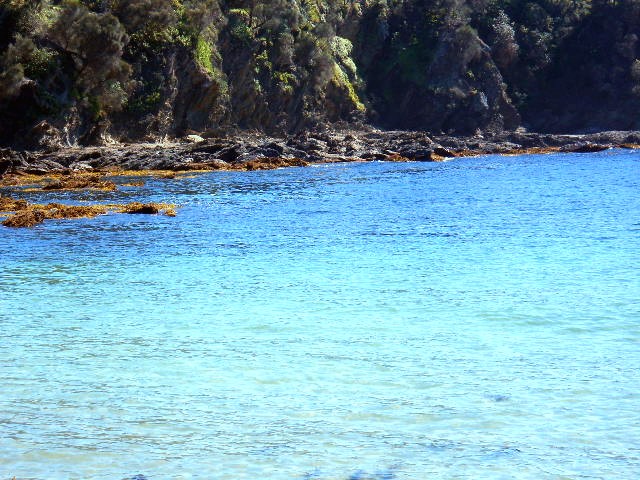 |
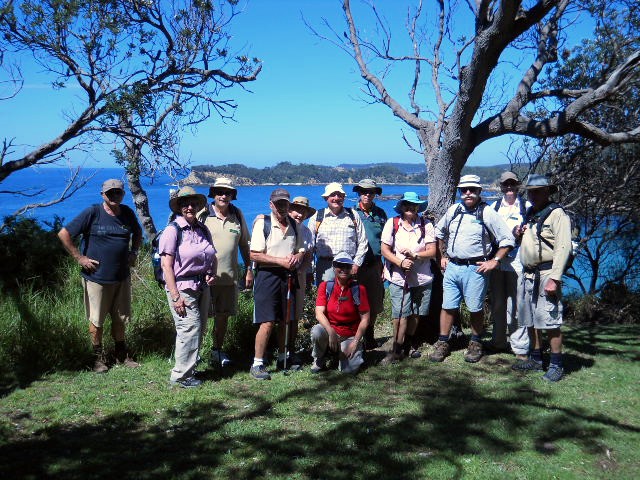 |
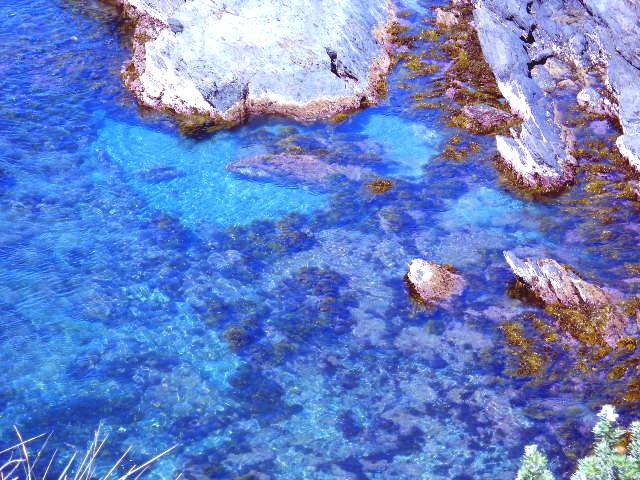 |
Inviting Garden Bay waters
Photo by Janelle
Click on thumbnail to enlarge photo |
Group minus 5 after cafe break
Photo by Janelle
Click on thumbnail to enlarge photo |
Clear pools in Malua Bay
Photo by Janelle
Click on thumbnail to enlarge photo |
On a warm summer morning, Thursday 7 March, 18 walkers assembled at Malua Bay.
The walk headed north around the Malua Bay headland with beautiful ocean views
of Malua Bay. Most of the walk was flat with a couple of narrow paths as we
headed across a bay and up around the second headland leading to Mosquito Bay.
The pace was leisurely and matched the convivial mood of the walkers, who all
agreed we were privileged to be living in such a lovely part of Australia.
The Bakery at Mosquito Bay was popular for morning tea/coffee and most of the
walkers returned to their cars at Malua Bay by the same route in reverse.
Many thanks to Jean, the day's leader.
Julie
back to Top
Car Camp at Bendethera in Deua National Park
Monday 4 - Thursday 7 March 2013
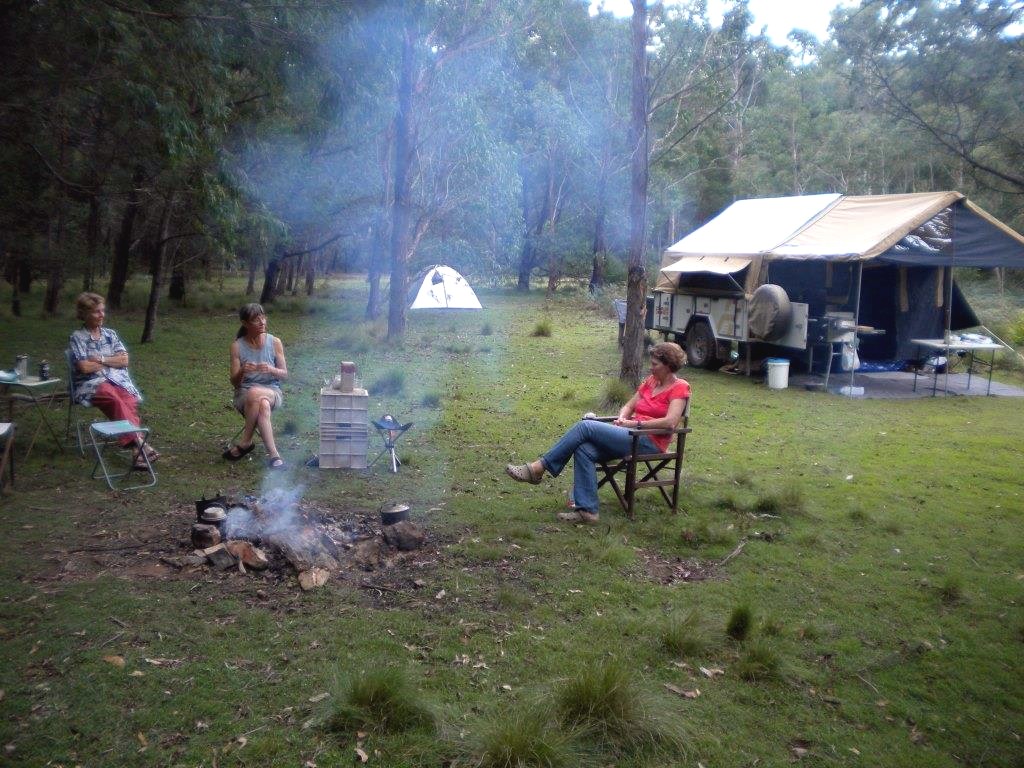 |
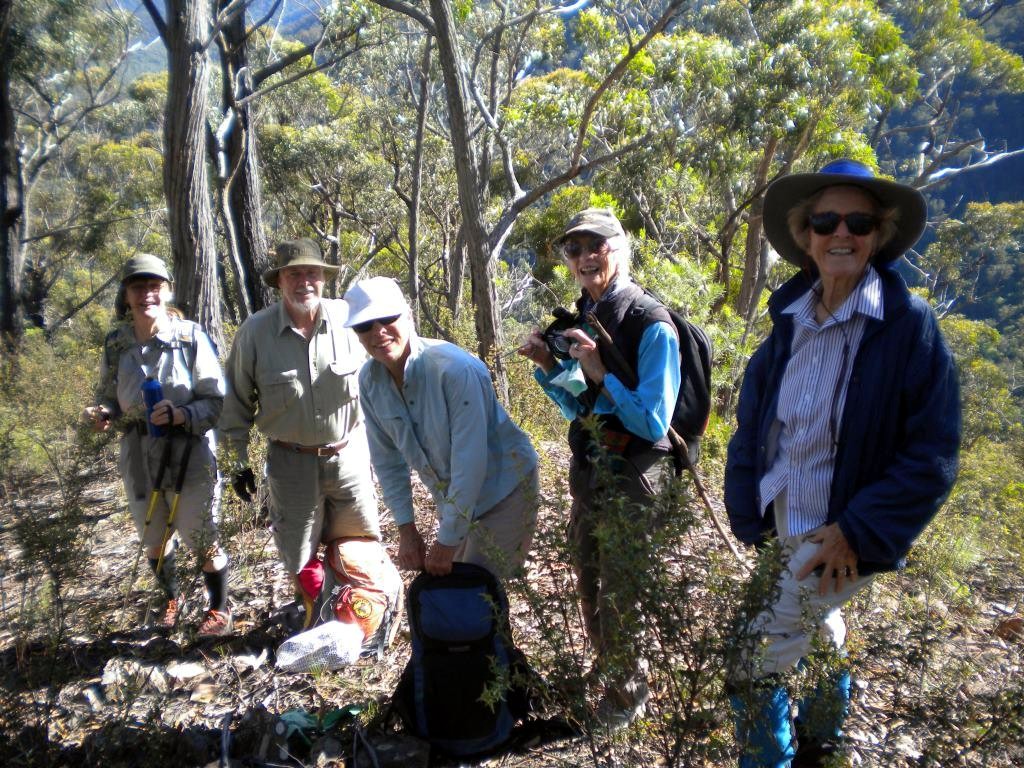 |
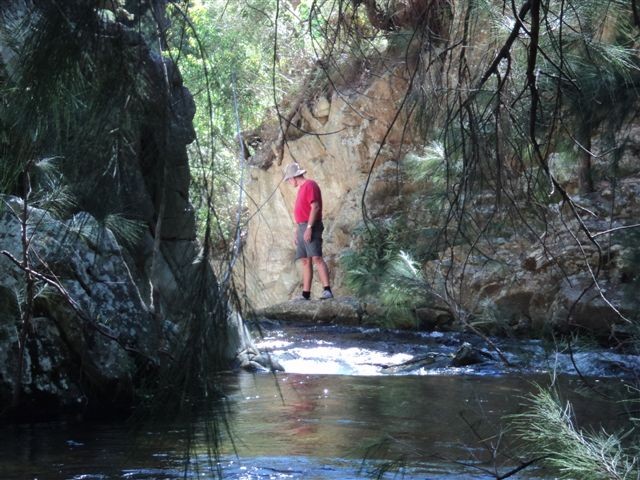 |
Bendethera, a relaxing campground
Photo by Ian
Click on thumbnail to enlarge photo |
Bronwyn, Bob, Sharon, Val and Betty
put on crampons for the big descent
into the river
Photo by Ian
Click on thumbnail to enlarge photo |
Ian contemplates the drop in the river diversion cutting
Photo by Bob T
Click on thumbnail to enlarge photo |
Bendethera is on the Deua River within the heart of Deua National Park. It is
remote and accessible only by 4wd. Although it is well known and reasonably
popular during holiday weekends, we saw only one other car in four days.
The camping area is an old farm, first settled in the 1860’s. Its 3km of
river banks are grassy and extensive, so finding a spot by the river is not
difficult. Apart from being a mecca for camping and four wheel driving,
Bendethera can also be used as a handy base for bushwalking in the surrounding
thousands of hectares of rugged ridges and valleys. However, one must be prepared
for some serious ups and downs because the altitudinal range is often up to 900
metres over short distances.
Our camp of three nights, in superb weather and on lawn like green grass,
attracted seven Club members (Sharon, Betty, Bob T, Val, Bronwyn, Lin and Ian)
and we went for two day walks, the first a little more adventurous than the second.
On the first day, by squeezing all seven into a Land Cruiser and grinding our
way up Bendethera Fire Trail, then down the Deua Fire Trail to the south, we
launched westward into the 1994 declared Deua-Woila Wilderness Area south of Dry
Creek. Almost immediately it was down, down, down, dropping 400m elevation in
little over a kilometre. Mountain goat country.
As planned, we hit the Deua River right at one of Australia’s most remote
artificial waterfalls. Possibly a century ago, gold miners diverted the water
at the gooseneck of a large loop in the river, thereby gaining access to a
kilometre of the river’s alluvial bed. The diversion is only 20 metres in
length for the water to rejoin the river, but to achieve it the miners tore
down a solid rock wall 10 metres in height. The resulting waterfall is 4 metres
in height with an opening of 8 metres in width. It is a very interesting site
and would be a very impressive sight in a flood!
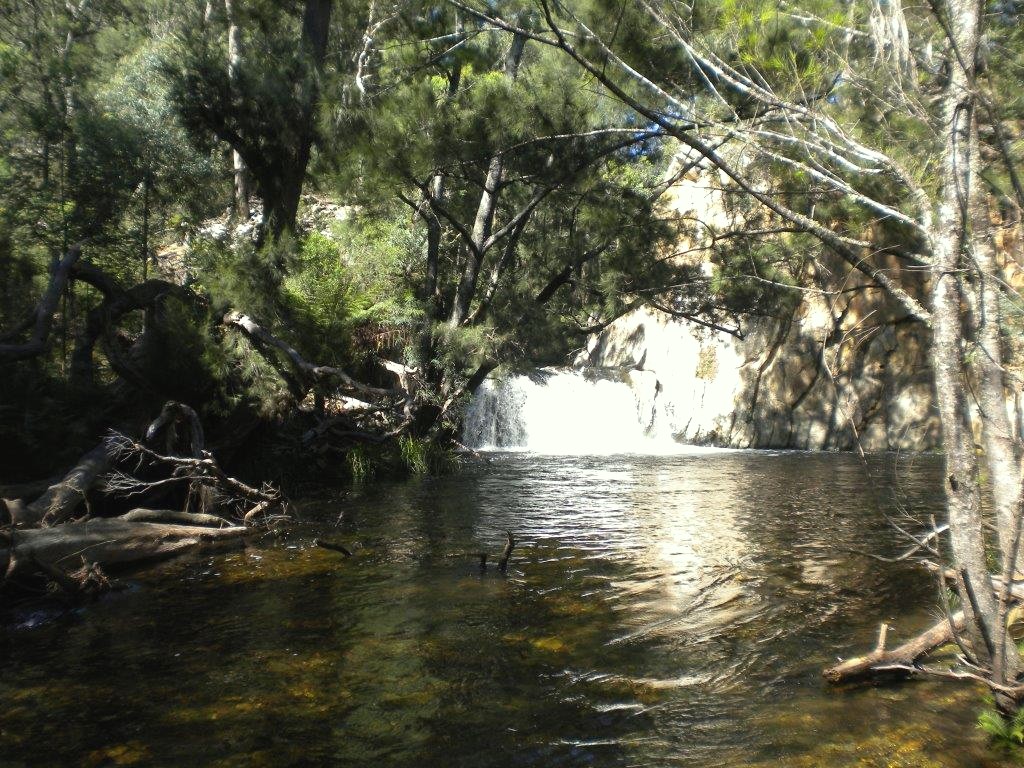 |
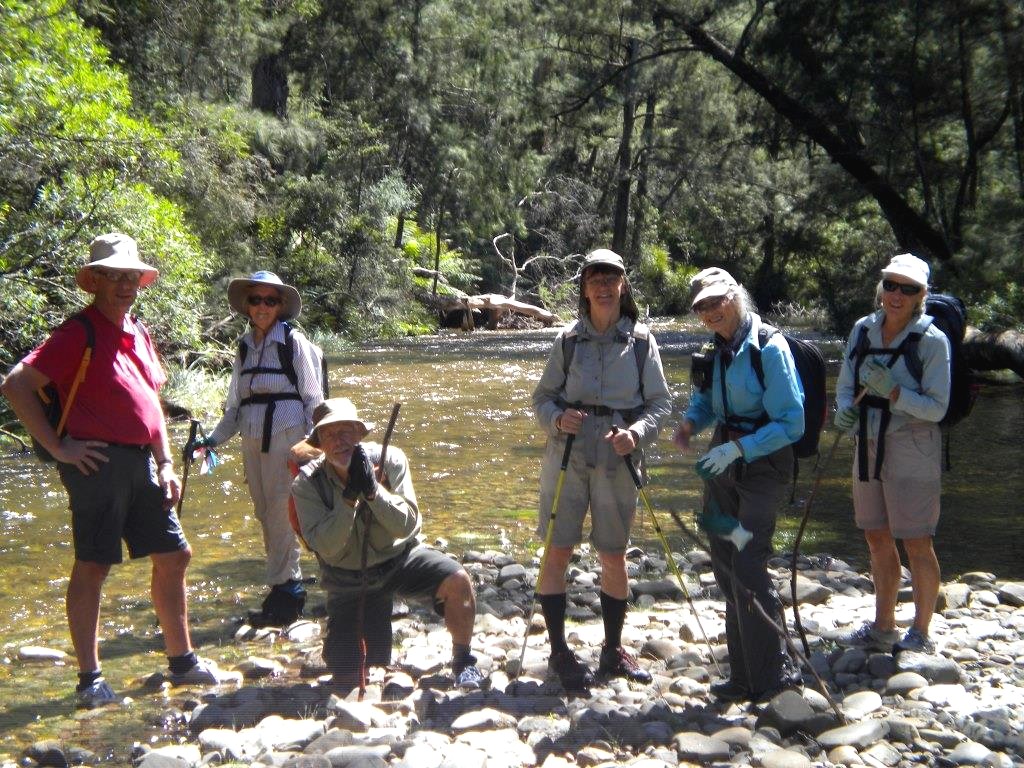 |
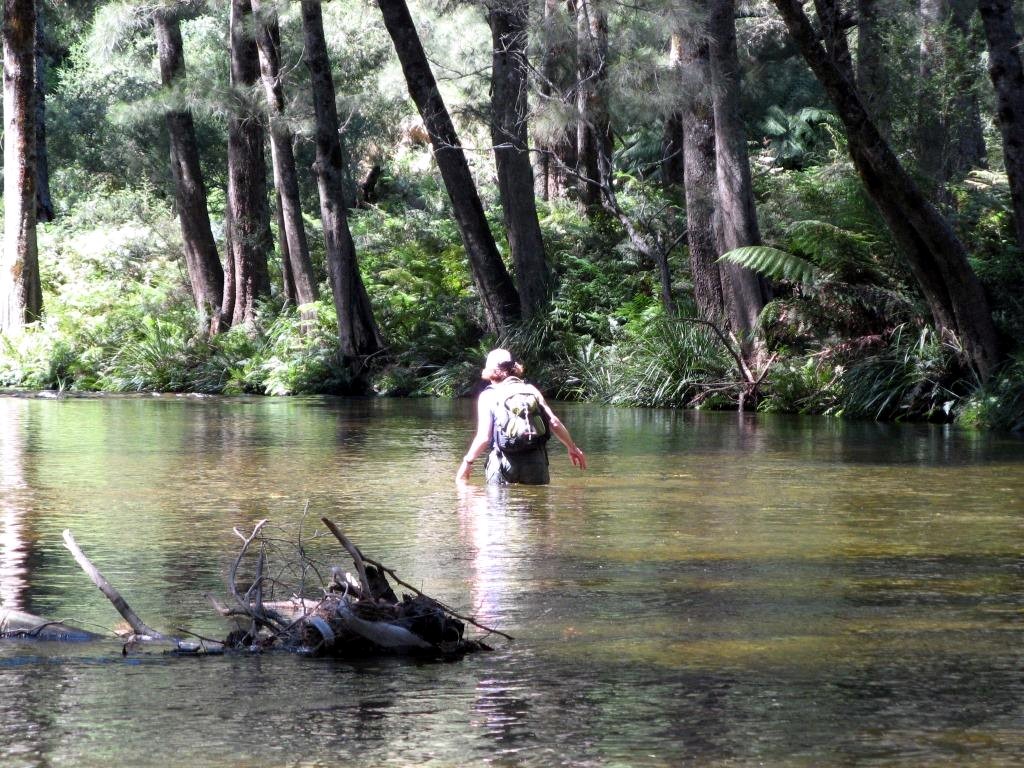 |
One of Australia’s most remote
artificial waterfall
Photo by Ian
Click on thumbnail to enlarge photo |
Riverbed walking at its best
Photo by Ian
Click on thumbnail to enlarge photo |
Lin gets right into it
Photo by Ian
Click on thumbnail to enlarge photo |
We then made our way six kilometres downriver to the camp, crossing from
side to side and often wading the gravel beds to avoid the thick bracken on the
river bank laced with raspberry plants and stinging nettles. Fairly leechy too.
The river was running a good fresh and the going was a bit tough at times.
Our bare shins did not fare well. However, the crystal clear water, the
brilliant green water cressed shallows and the river oak groves all made it worth while.
The second day’s walk could not begin until we retrieved the car left on the
Deua River Fire Trail the previous day. Imagine our shock to round a bend in
the trail many kilometres in and be confronted with a freshly fallen large log.
And not a breath of wind over night! Thankfully it was mostly rotten and after
half an hour of ripping it apart with our bare hands we gained just enough
thoroughfare to solve the problem.
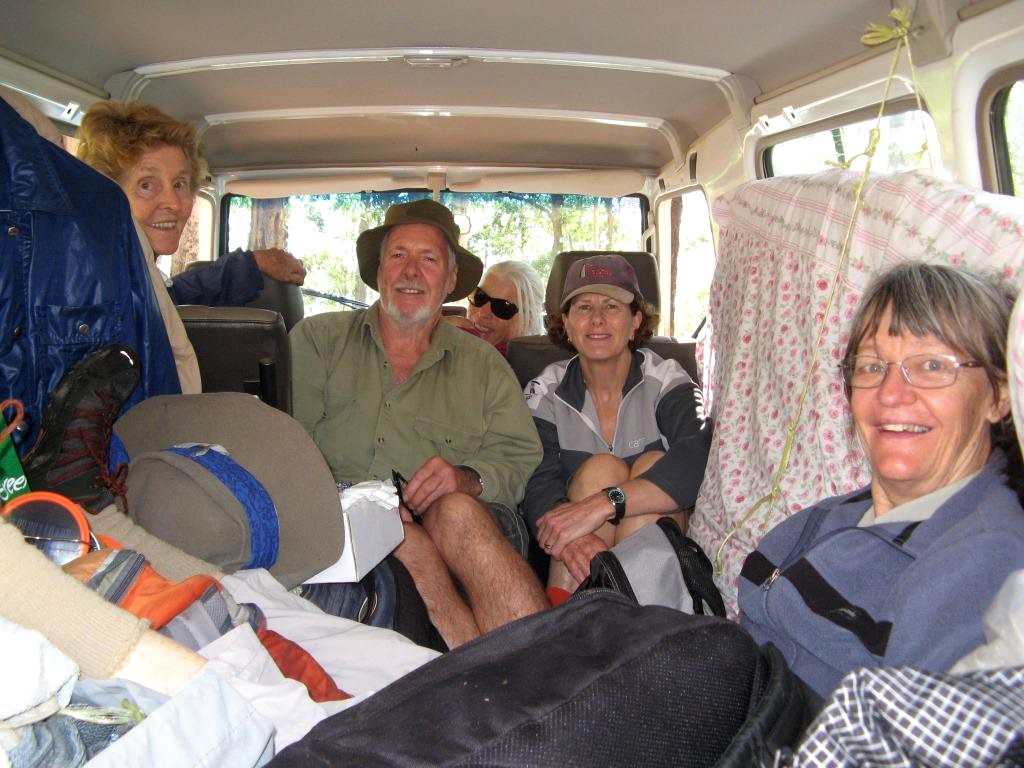 |
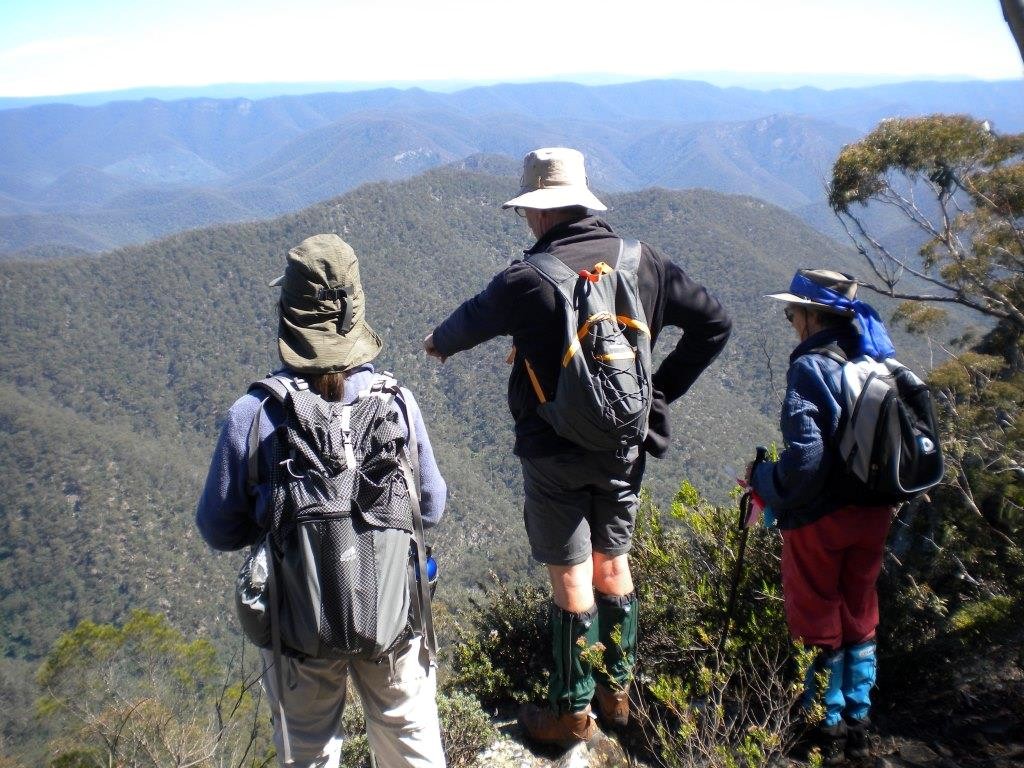 |
Car shuffling rarely gets more comfortable
Photo by Ian
Click on thumbnail to enlarge photo |
The view west from Bendethera “rocks”
Note the hillside of grey/green Bendethera
wattle at Bendethera Cave in the left distant
Photo by Ian
Click on thumbnail to enlarge photo |
Our short walk for the day began just to the north of Bendethera Trig where, on
a ridge jutting westward, a large spine of bedrock overlooks the Deua River some
800 metres below. From the clifftops, and under rare Jillaga Ash, the views to
the west were superb and extensive, including to the Great Dividing Range where
only two weeks before we had walked in the Snowball area.
We returned to camp, swam the refreshing waters of the river, supped coffee,
and enjoyed an afternoon nap in the warm afternoon sun.
Great place, great weather, great walking, great company.
Ian
back to Top
Exploring West Nelligen
Saturday 2 March 2013
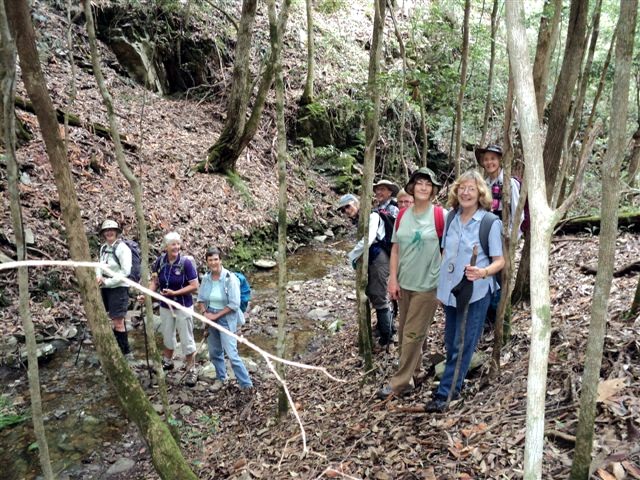 |
Bushbashing west of Nelligen
Photo by Bob T
Click on thumbnail to enlarge photo |
Proving again that, after more than a quarter of a century of regular
activities, Batemans Bay Bushwalkers are still finding new areas to explore,
a group went into the hills west of Nelligen, and enjoyed some features which
our leaders had discovered.
After following several old tracks, we descended into a lovely gully where
water from the recent rains was babbling and tumbling over the moss and lichen
covered rocks. Some interesting rock strata were found, and the surrounding
forest watched silently as we carefully followed the gully down to a point where
we had to leave it.
A slow and laborious climb up a steep slope to another track on top of the
ridge earned a rest, while we discussed the interesting features of the gully,
and enjoyed the pleasure that comes from exertion and the company of good friends.
Bob T
back to Top
Batehaven Town and Country Ramble
Wednesday 27 February 2013
Thirty five enthusiastic walkers arrived at Corrigans Beach Car Park for the
Batehaven Town and Country Ramble led by Charles and Karen C. Twenty seven took
off at 10 am for the 6km less strenuous walk, and there was a lot of noisy
talking and laughter as we rambled along Beach Road towards the high school. We
could have been mistaken for a bunch of excited high school kids, except for all
the grey hair. What a surprise to find a short distance out of suburbia we were
in bushland.
A beautiful pure white egret was spotted in one of the dams showing a perfect
reflection, shame no one carried a camera. Morning tea break was taken beside a
nice dam. Some of us came home with souvenirs from hundreds of mosquitos,
despite lots of spraying.
Eight other walkers led by Karen C took a longer distance walk of 9.5km to
the Round Hill Lookout, at the back of Batehaven. They were challenged by a few
steep hills I believe. We all joined in and ended a wonderful morning with a
very social BBQ lunch at Corrigans Beach.
A great morning enjoyed by all, thank you Leaders.
Ailza
back to Top
Merry Beach to Bawley Point
Sunday 24 February 2013
Cancelled due to wet weather
back to Top
Old Bolaro Road, Rainforest and Granite Cascade
Thursday 21 February 2013
Walk cancelled due to wet conditions
back to Top
Great Divide Car Camp No. 3 at Snowball
Friday 15 - Sunday 17 February 2013
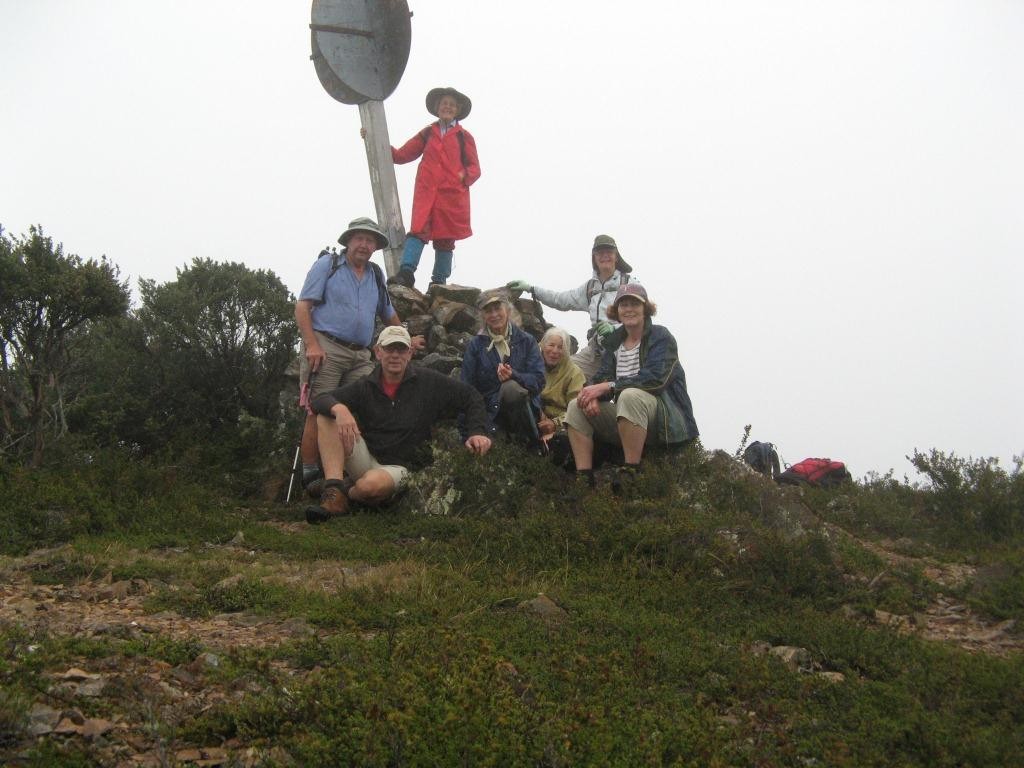 |
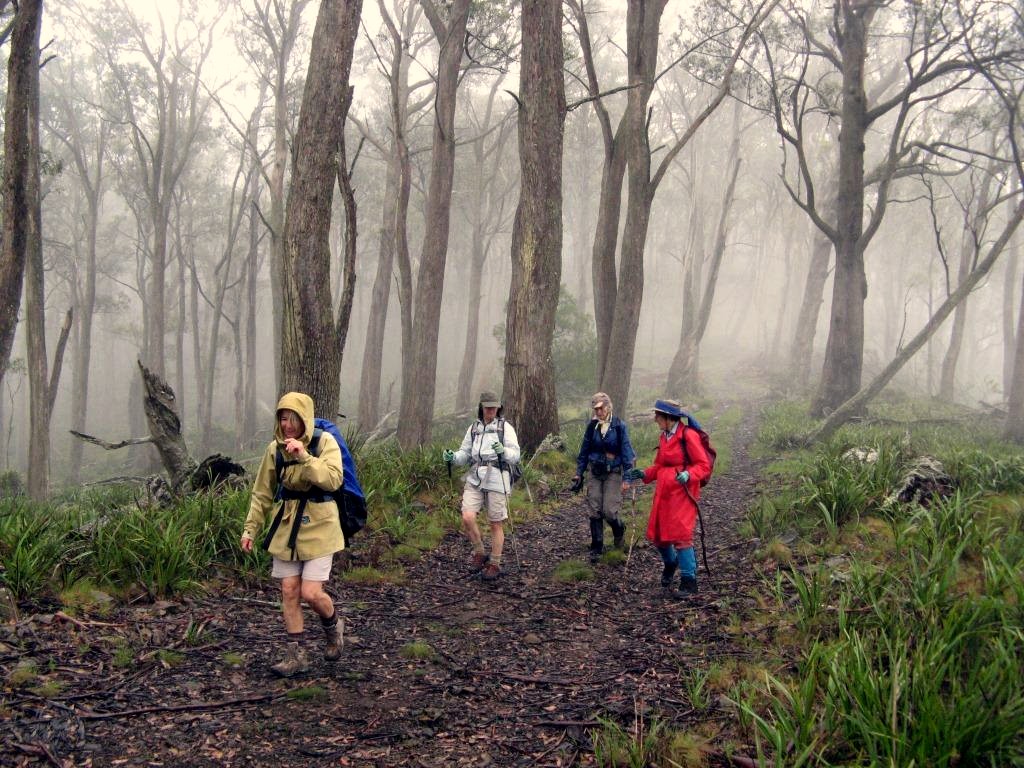 |
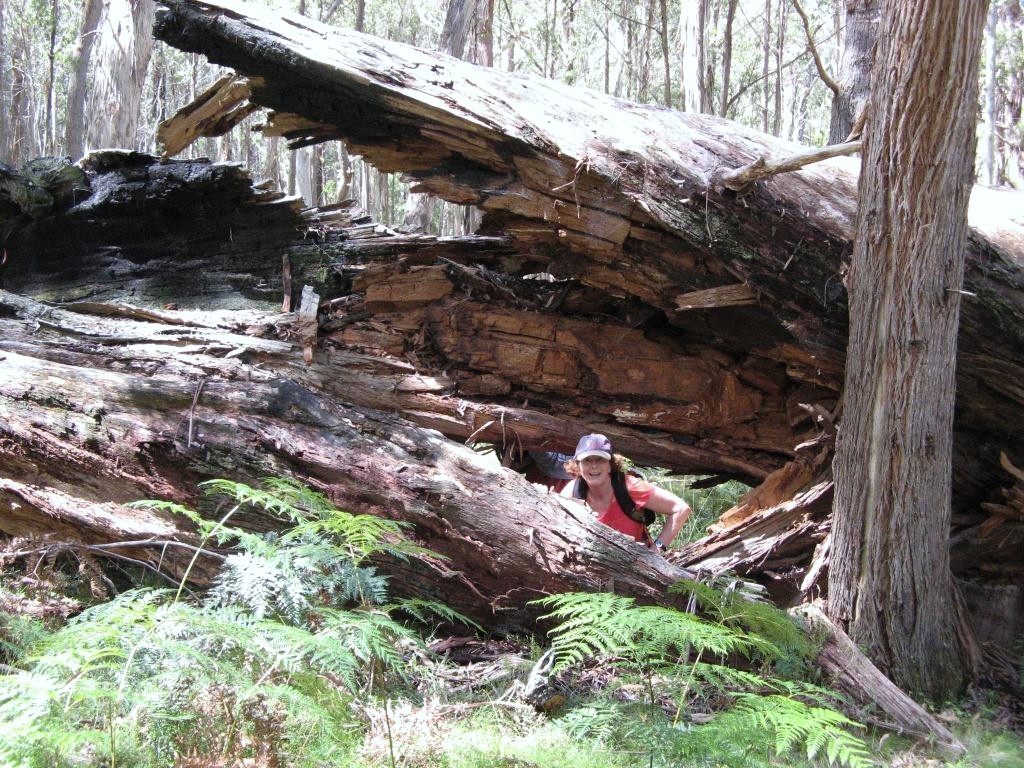 |
Len, Ian, Betty, Val, Sharon, Bronwyn and Lin at the Big Badja trig
Photo by Ian B
Click on thumbnail to enlarge photo |
Sharon, Bronwyn, Val and Betty enjoy the early morning Great Dividing Range fog on Big Badja Mountain
Photo by Ian B
Click on thumbnail to enlarge photo |
Lin wonders why the leader chose a path through a tree
Photo by Ian B
Click on thumbnail to enlarge photo |
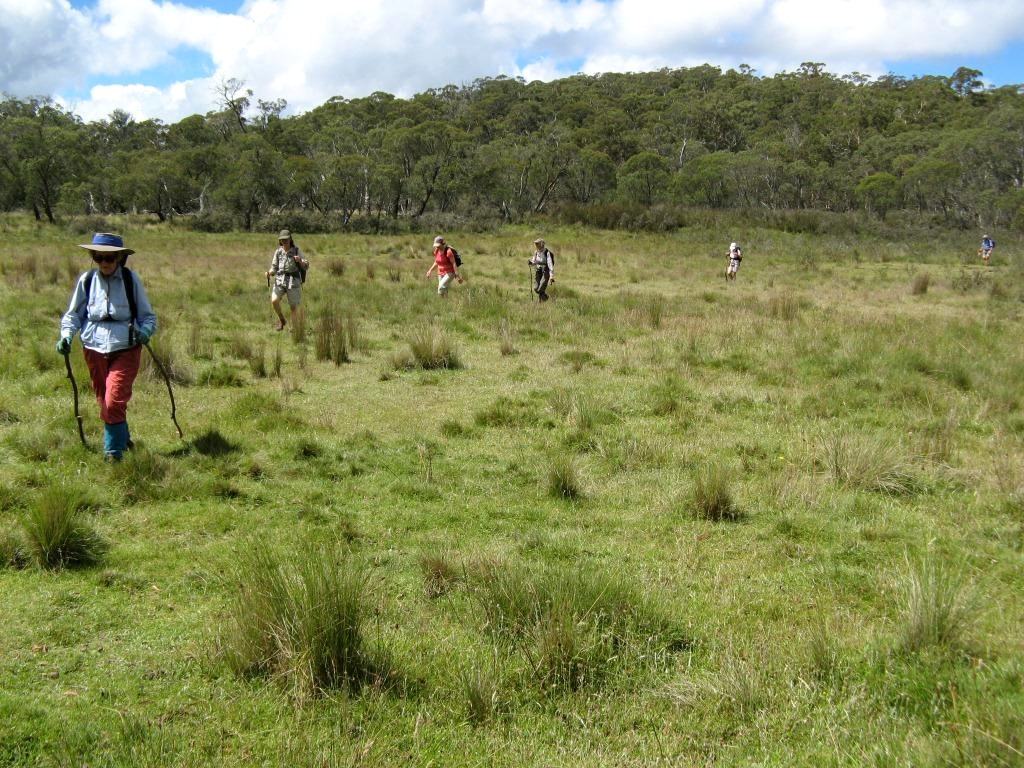 |
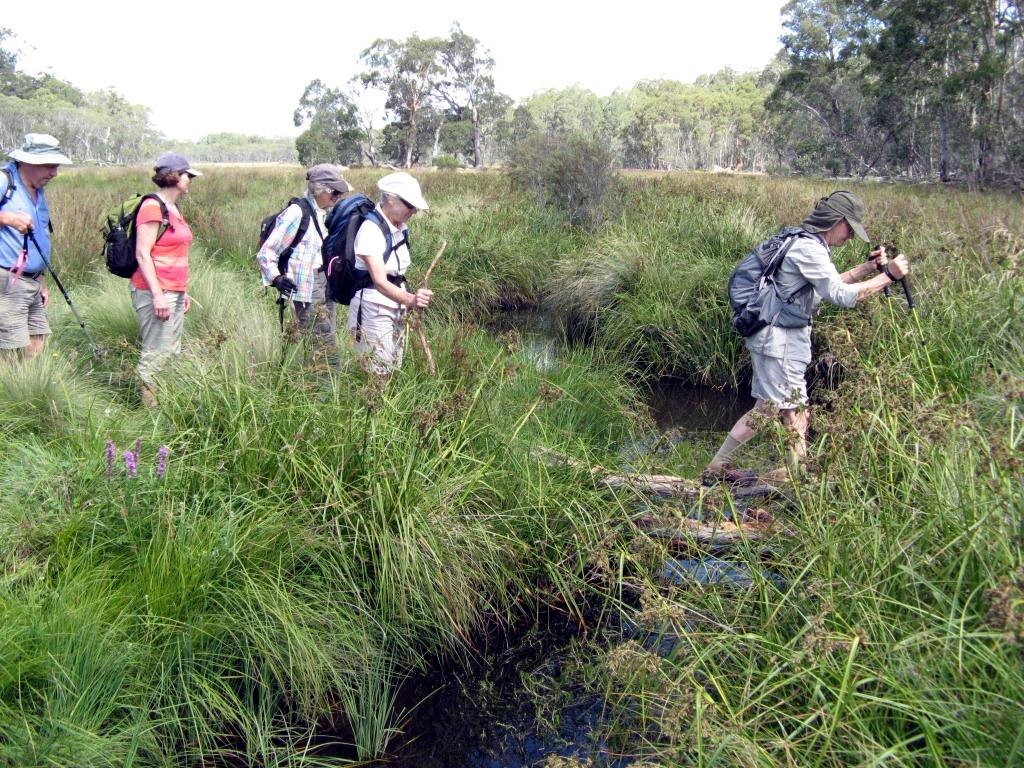 |
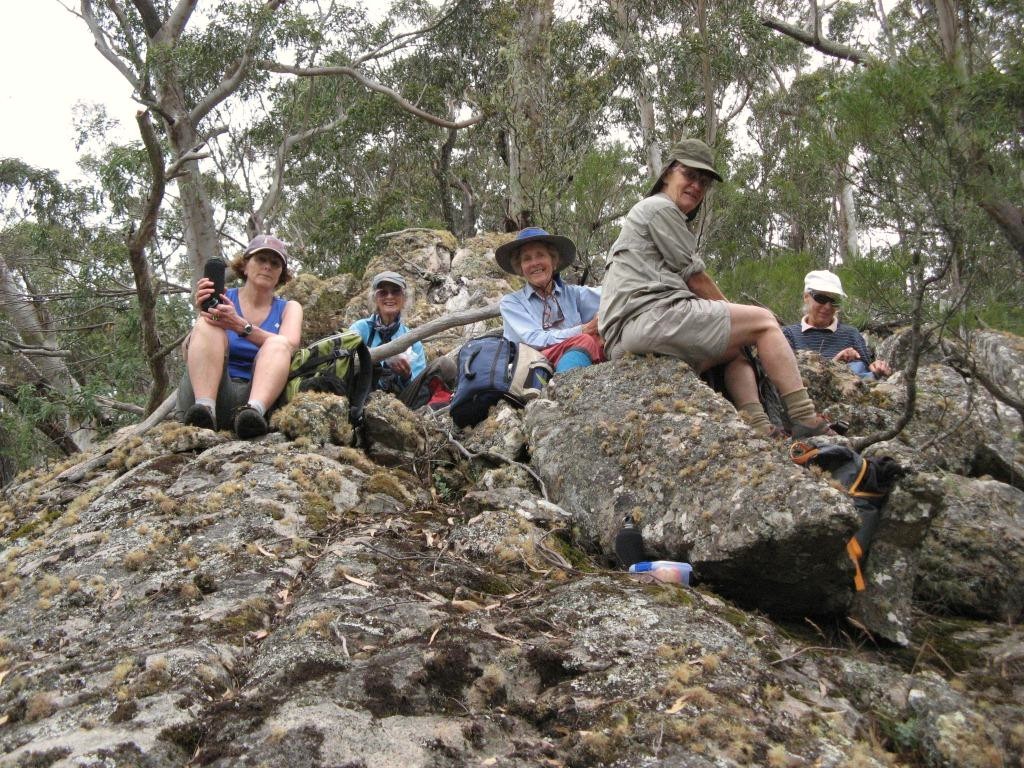 |
Meadow walking in the Badja Swamps
Photo by Ian B
Click on thumbnail to enlarge photo |
Crossing the upper Badja River on a makeshift bridge
Photo by Ian B
Click on thumbnail to enlarge photo |
Morning tea on a rocky outcrop on Middle Mountain
Photo by Ian B
Click on thumbnail to enlarge photo |
The third camp of our exploration of the Great Dividing Range was on Middle
Mountain Road, Snowball. Nearby was the Currambene Creek which is the uppermost
catchment of the mighty Shoalhaven River. The flat campsite was very comfortable
with ample firewood and water.
Our seven Club members enjoyed two exploratory day walks in the Snowball/Pike’s
Saddle area, familiar to Braidwood-Cooma Road motorists, both walks graded
medium to medium/hard.
Saturday’s walk initially followed the Great Dividing Range ridgeline
southwards from Pike’s Saddle along a fire trail. We called into the Big Badja
Mountain trig of 1,362 metres, but unfortunately the early morning fog obscured
the views. We contemplated the fact this area has five significant rivers
arising in the near vicinity – the Shoalhaven, Deua, Tuross, Badja and Queanbeyan
Rivers. Also, and perhaps uniquely in NSW, on a clear winter’s day both the
snow and the sea can be seen from the Big Badja trig.
At an appropriate point further south we cut westward through open Brown
Barrel forest and snow grass toward Badja Swamps. The flat, spongey plains are
the upper catchment of the Badja River which ultimately flows into the
Murrumbidgee River. Thankfully, the swamp plains were dry and the walking in
and out of Snow Gum forest and grassy meadows was most pleasant.
Negotiating the Badja River itself required a quick temporary bridge. The
camera was ready for a highly prospective collapse to the water but everyone
“passed weight” and no fall was offered. A short walk up to the Braidwood-Cooma
road and we were able to find our waiting car for return to camp.
Sunday’s walk was closer to camp. We traversed the Middle Mountain range
north to south which splits the two arms of the upper Shoalhaven River. The
walking was a bit tough in places with heavy rock and log and stick debris
requiring constant negotiation.
From a high rock outcrop we enjoyed a lovely view of the upper Currambene
Creek catchment and distant views of upper Woila Creek and Mother Woila
mountain within the Tuross River catchment.
After a scrubby descent of the southern end of the range we struck Middle
Mountain Road and after a trudge reached camp by mid afternoon.
Great Divide Explorations Camp 3 proved to be a very pleasant weekend of
exploring and creekside camping.
Ian B
back to Top
Congo to Meringo, Dreaming Track
Saturday 16 February 2013
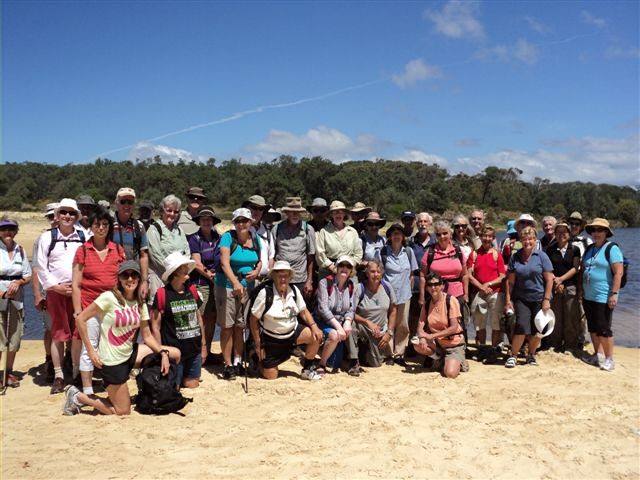 |
Every Tom, Dick and Harry and a few Bobs
Photo by Bob T
Click on thumbnail to enlarge photo |
Forty enthusiastic walkers, including guests from Germany and England set
off on a very sunny and warm Saturday to discover the Northern section of the
Dreaming Track, located some 10 kilometres south of Moruya.
This is one of the most popular walks for members of the Batemans Bay
Bushwalking Club, as it is reasonably level and takes in some wonderful coastal
views whilst walking on shaded bush tracks.
On the way, a grave complete with headstone dated 1865 was discovered. Thanks to
Leaders Barbara and Ron for safely shepherding the crowd around the track.
Charles
back to Top
Quartpot Creek, Toward the Source
Wednesday 13 February 2013
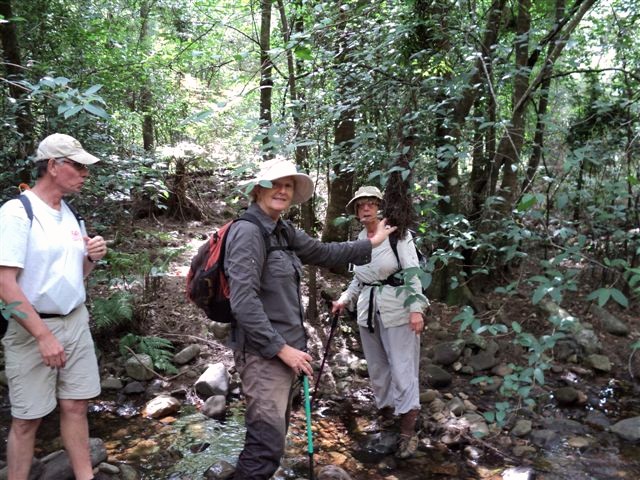 |
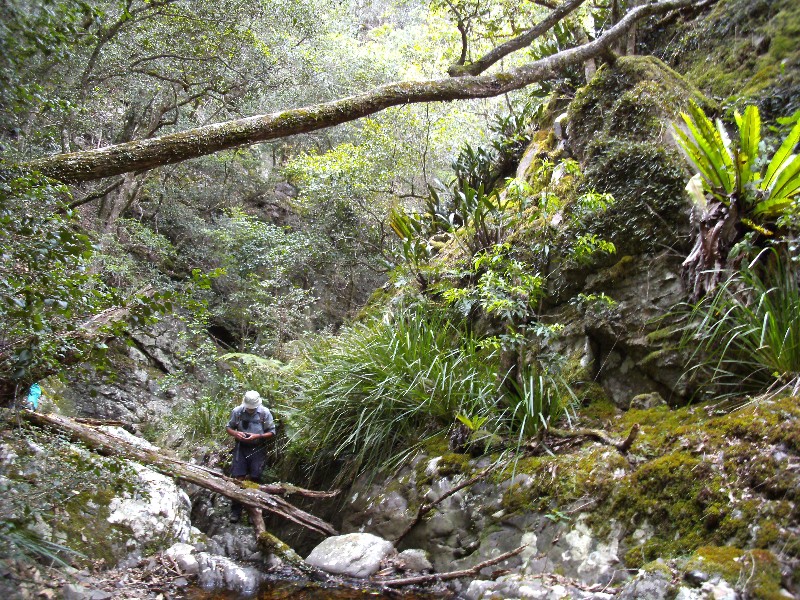 |
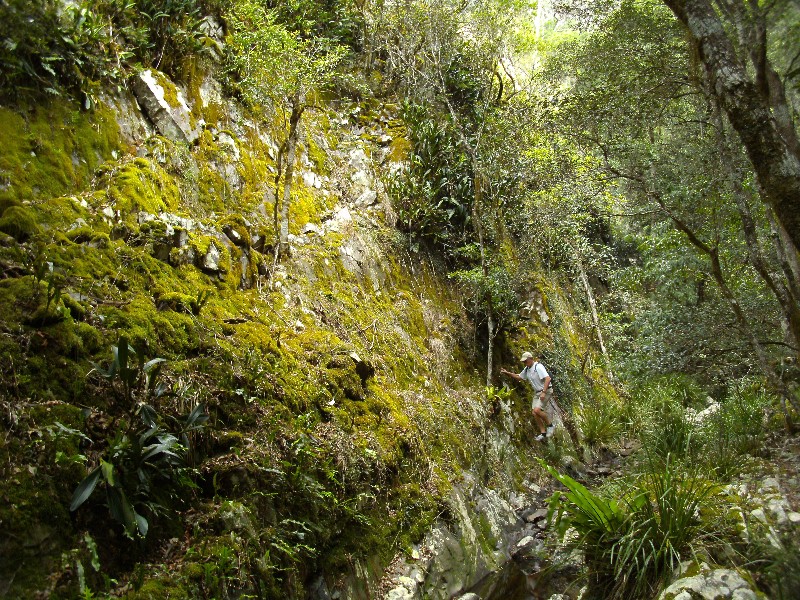 |
White browed scrub wren nest
Photo by Bob T
Click on thumbnail to enlarge photo |
Stan climbs the side creek
Photo by Karen M
Click on thumbnail to enlarge photo |
Ian among the mosses, ferns and rock orchids
Photo by Karen M
Click on thumbnail to enlarge photo |
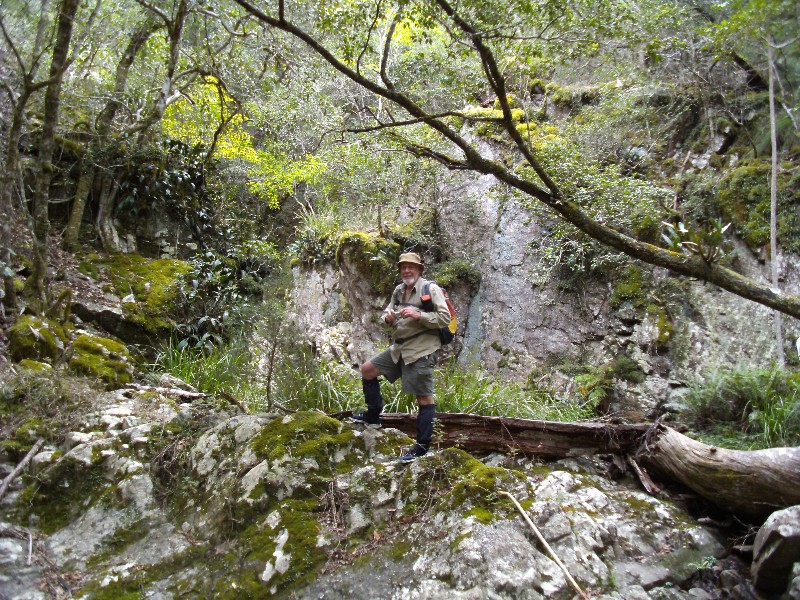 |
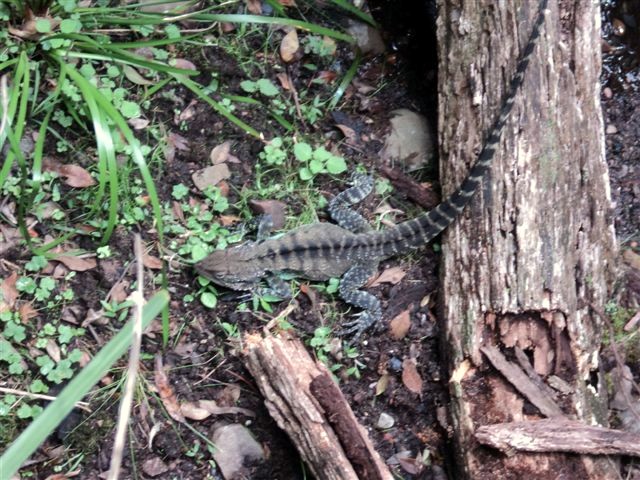 |
Bob at top of side creek
Photo by Karen M
Click on thumbnail to enlarge photo |
Water Dragon looking for a bit of peace and quiet
Photo by Bob T
Click on thumbnail to enlarge photo |
After an interesting drive in to the top one of 10 crossings on Quartpot
Creek, seven members set out to discover the features of the upper parts of the
creek. We waded and wandered towards the source through pools and forest,
finding cascades, scrub wren nests, thickets of birds nest ferns, and leeches.
The scrub wren nests look like flood debris, hanging from the end of branches
over the water, with a secret entrance and emergency exit. Being located there makes it
hard for any predators to access them.
When we stopped for lunch, we discussed options, and though our original
plan was to return down the creek, Ian suggested turning in to the southern
tributary, and exiting up a hill to the top of the track. As this was an
exploratory, the idea appealed, and it was an inspired suggestion, as we soon
found ourselves in a remarkable ravine. Over millennia, the creek had cut
and tumbled down through soft rocks, creating a mystical gorge, with vertical
rock faces which had beautiful strata, and swathes of rock orchids, ferns and
mosses decorating this most unusual feature. It felt like the Garden of Eden.
After a stiff climb, we found the track, and happily ambled a couple of
kilometres back to the cars, satisfied that we had found one of the most
beautiful features in this area, and now have another walk option for the Club.
Even the discovery of more leeches and feet leaking blood from several holes
failed to affect our feeling that we had more than achieved our objective.
Bob T
back to Top
Sugarloaf Creek, Misty Mountain Descent
Sunday 10 February 2013
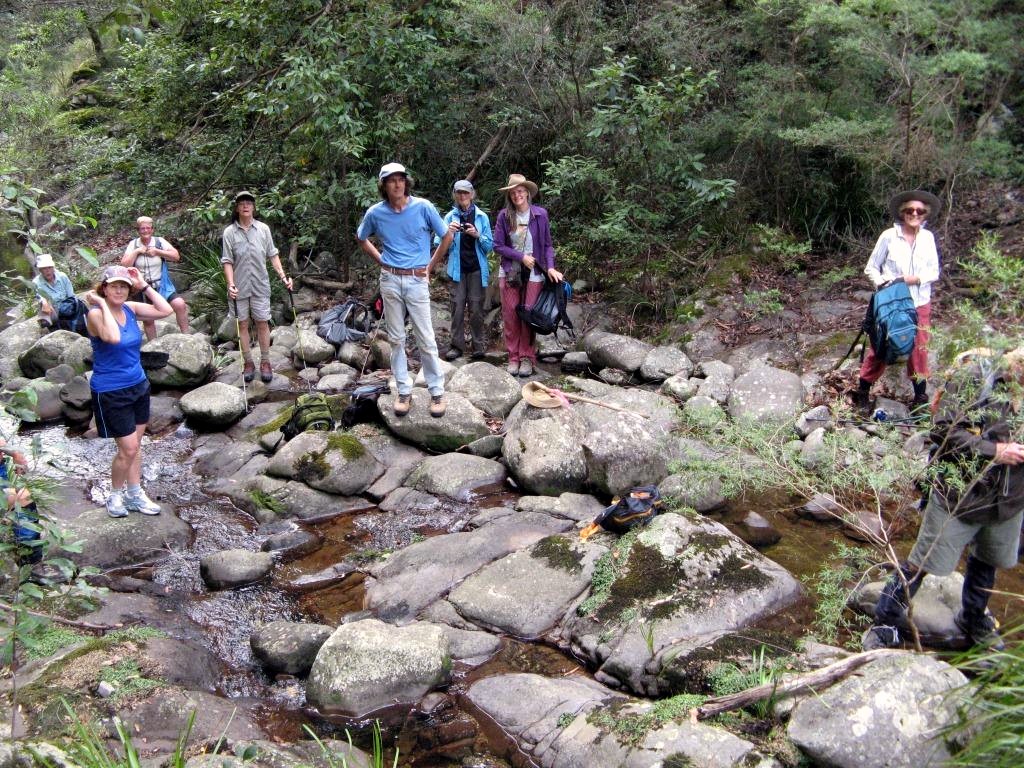 |
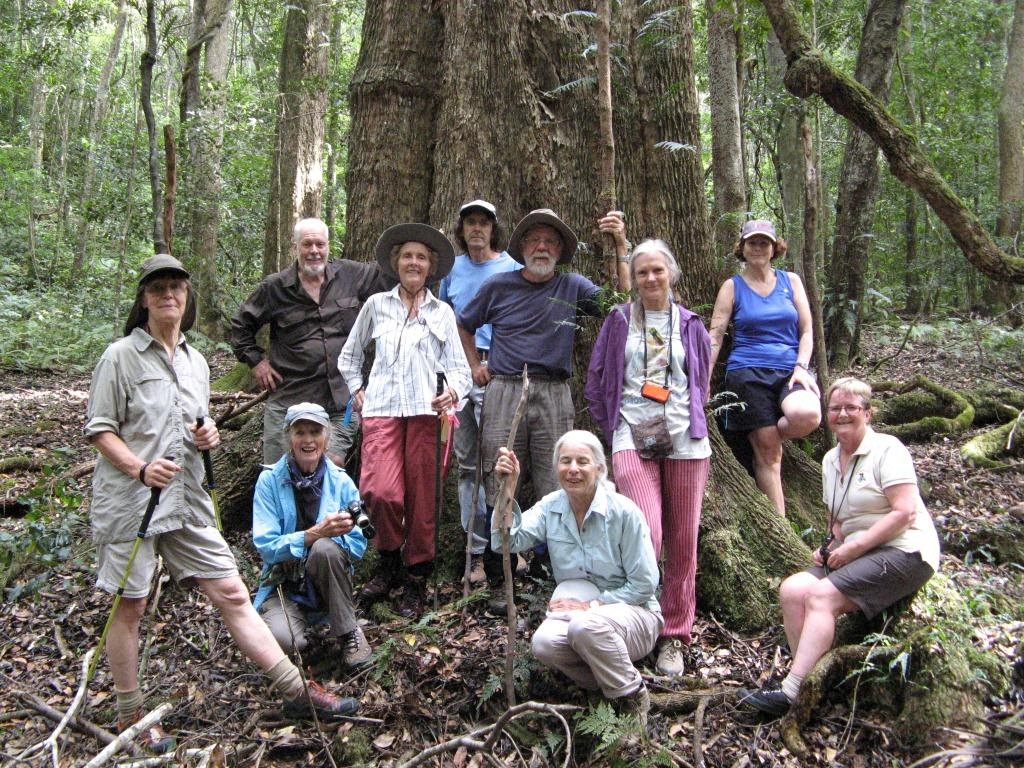 |
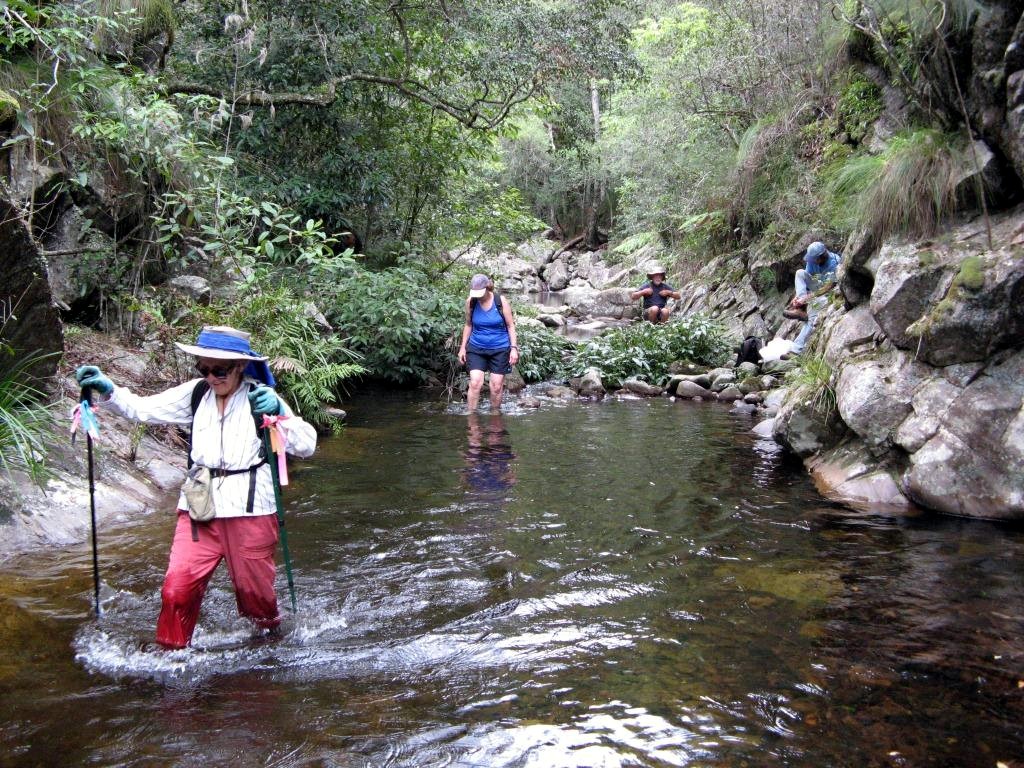 |
All bright and bushytailed at the start
Photo by Ian B
Click on thumbnail to enlarge photo |
In the rainforest and framed by a large soapybox
Photo by Ian B
Click on thumbnail to enlarge photo |
Betty leads the way through the shallows
Photo by Ian B
Click on thumbnail to enlarge photo |
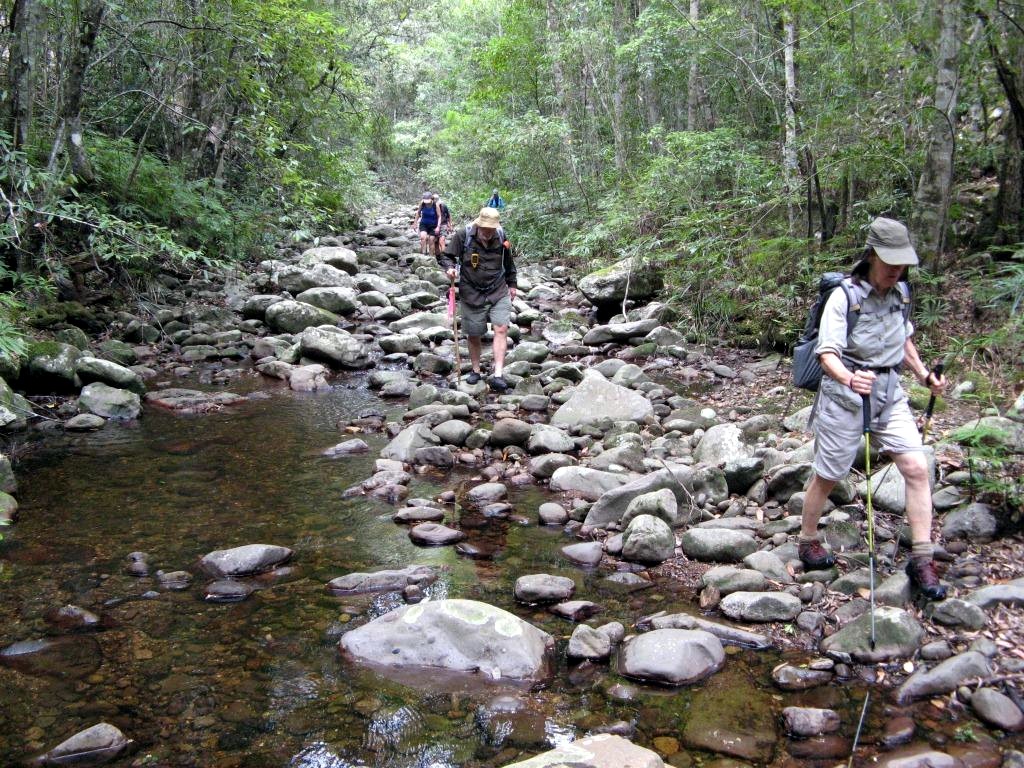 |
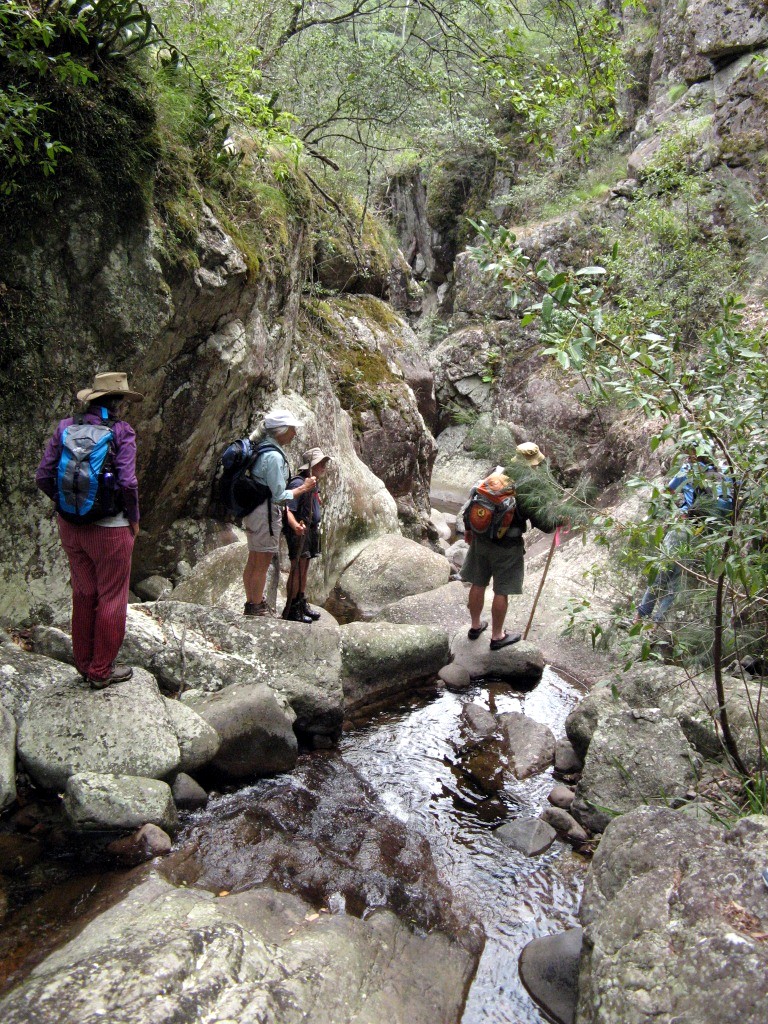 |
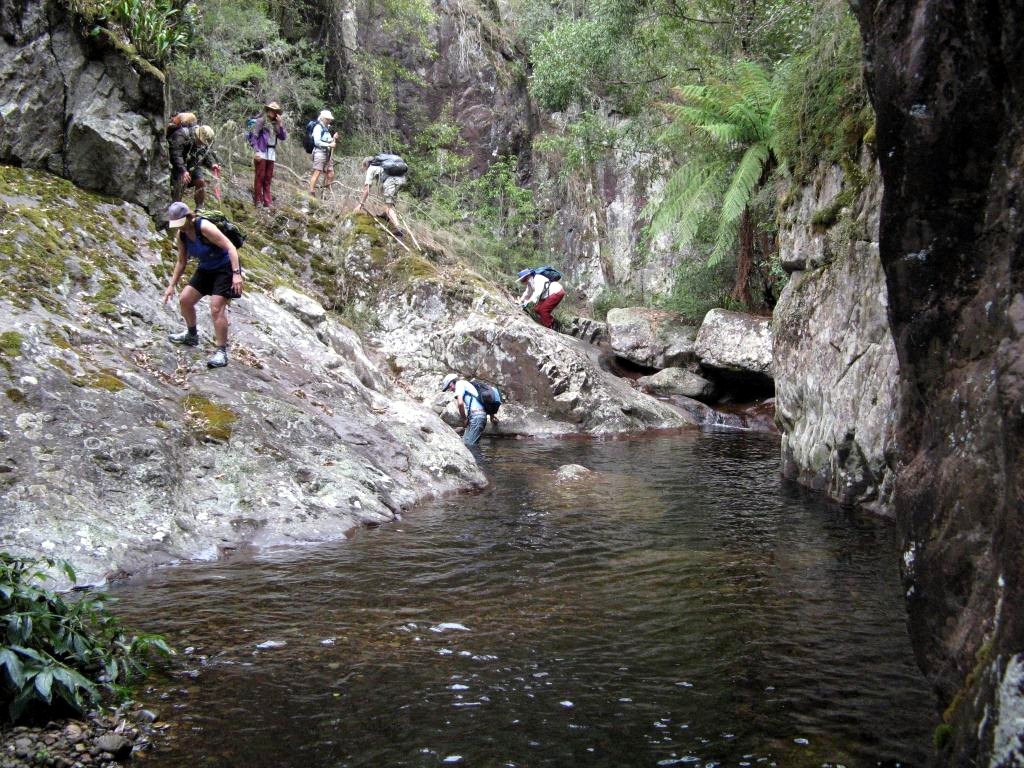 |
Like Brown's cows it's hard to get
lost in a creek
Photo by Ian B
Click on thumbnail to enlarge photo |
Hmmm, looks a bit tight down there
Photo by Ian B
Click on thumbnail to enlarge photo |
Easy wet way or tricky dry way
Photo by Ian B
Click on thumbnail to enlarge photo |
This descent of Sugarloaf Creek (the Misty Mountain one) was enjoyed by
eleven Club members. The walk was short in distance(5km)but relatively long
in time 5 hrs),and in effort required.
Sugarloaf Creek is located south of the Kings Highway and is one of the major
creeks draining the steep Clyde Mountain escarpment. It lies to the west of
Misty Mountain Road within the Monga National Park, and is within a 9,180
hectare wilderness area declared in 2002.
We left a car on Misty Mountain Road at the Sugarloaf Creek bridge and then
continued up the road toward Misty Mountain itself. After leaving the car and
a peer over the side, the steep descent westward into Sugarloaf Creek soon had
thigh muscles bulging and kneecaps popping.
Upon plopping into the creek, and because we had plenty of time, we made a
short westward detour over a low ridge into the pleasant rainforest patch we
had previously explored in August 2012. The large Coachwoods and Soapy Box,
festooned with Birds Nest ferns, were still intact, obviously still healthy
despite the recent scorching hot days.
After some pleasant wandering through the open understory we returned to the
main creek and were soon hemmed in by occasional solid rock outcrops. Oh drat!
We had to wade through short sections of crystal clear water but surprisingly,
despite the pleasant water temperature, there was some reluctance to risk a wet
bum. After a couple of accidental swims, most soon got into the spirit of things.
A kilometre downstream the creek really tightened up with large rock outcrops
above us on the ridges. We were soon confronted with a solid rock slot, which
didn’t appear to drop significantly, but with twists and turns as far as the eye
could see. This raised the adrenaline levels – yahoo! - but unfortunately, a
chock stone prevented a full descent. However, after a high detour and a swim
upstream we were able to fully check it out from the bottom. Not a canyon by
any means, but an interesting feature nontheless.
Another interesting fact arose at this site. We now know that a Garmin GPS
dropped 5 metres onto solid rock, and bouncing from its rubber bottom, will
survive and still function. Bob T thoughtfully decided to conduct the test,
though we are not sure this was intentional at the time.
The rest of the descent was uneventful apart from yabbie and eel sightings
and a few leeches. The creek valley opened out and became a pleasant rock
hopping alleyway, finally terminating at the bridge and our waiting car.
In summary, a very accessible and pleasant creek descent.
From later reports, there were some weary and scratched up bodies that night
enjoying a very fitful sleep.
Ian B
back to Top
Point Upright
Thursday 7 February 2013
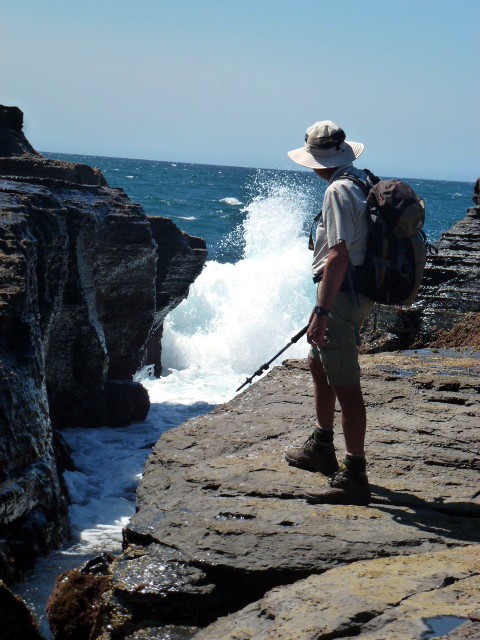 |
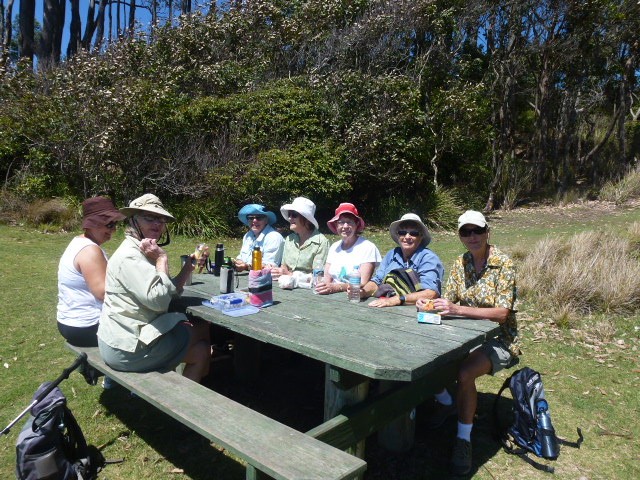 |
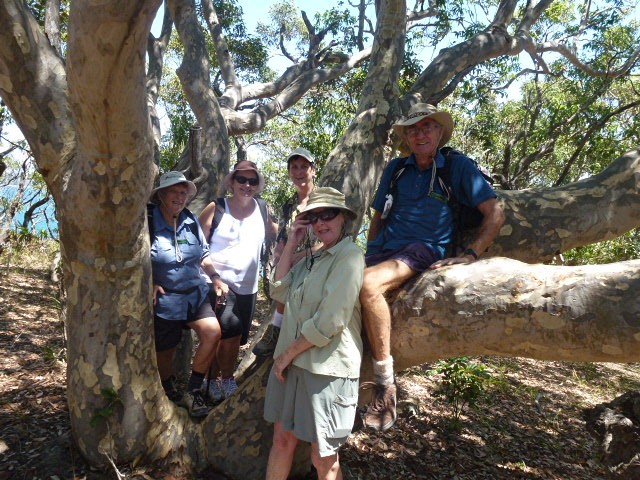 |
Stan on Point Upright rock platforms
Photo by Lesley
Click on thumbnail to enlarge photo |
Grassy picnic lunch spot
Photo by Lesley
Click on thumbnail to enlarge photo |
Twisted spotted gums on Point Upright
Photo by Lesley
Click on thumbnail to enlarge photo |
A beautiful sunny day forecast to be a hot one, but for nine bushwalkers the
day at the coast turned out to be the very best place to be, with a cooling
brisk wind lifting our hats, as well as giving every wave a white cap as far
as the horizon - perfect for the walkers.
We enjoyed morning tea in the shade at the northern end of Beagle Bay, North
Durras, and then continued along the bush track and around the extensive flat
rock platform below the vertical cliffs of Point Upright, where the waves were
spectacular as they crashed high over the platform edge.
Lunch was enjoyed at Depot Beach fanned by the brisk breeze and then
onwards up and along the top of Point Upright to the outer end where
views to the south were clear and impressive, before heading back down
to North Durras.
Thank you to Ainslie and Mike for taking us to this special part of
the coast.
Joan
back to Top
Currowan Creek Meander
Saturday 2 February 2013
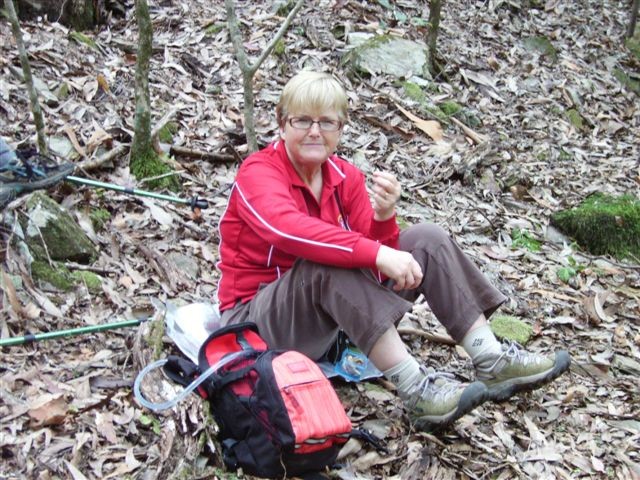 |
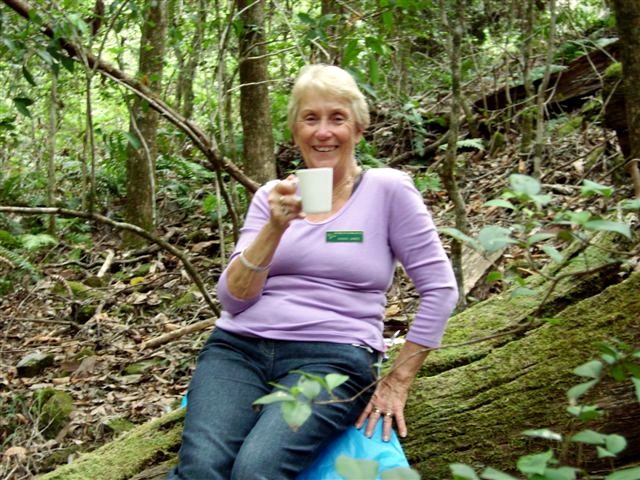 |
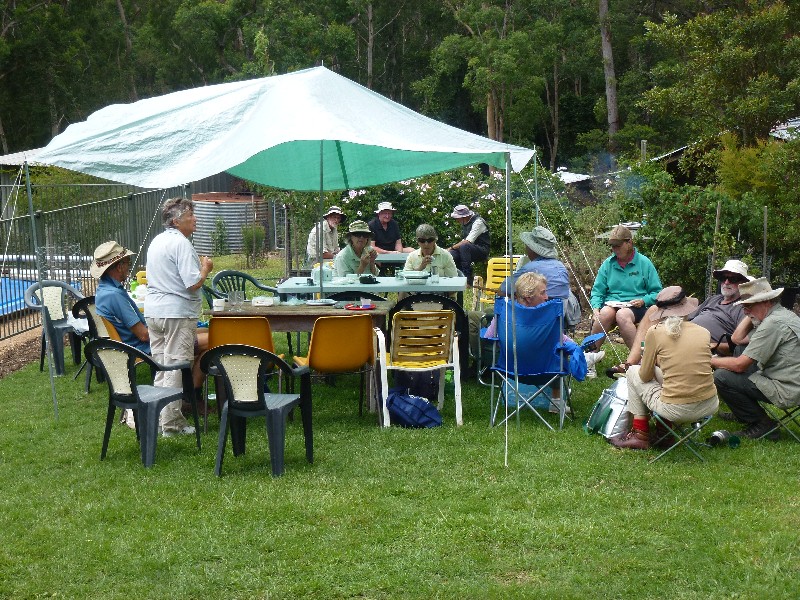 |
Kay
Photo by Karen C
Click on thumbnail to enlarge photo |
Denise
Photo by Karen C
Click on thumbnail to enlarge photo |
Devonshire Tea at Cliffs after walk
Photo by Lesley
Click on thumbnail to enlarge photo |
Twenty seven Bay Bushwalkers enjoyed an easy-going creek meander just off the
Western Distributor Road last weekend, led by leader and host Cliff.
The bubbling little brook was pristine and we saw frogs and little dragons
along the way; some tiny native orchids, and lovely rock faces edging the creek
in places. The fresh green understory of native shrubs and beautiful gum trees
reflected in the creek were also a big feature of the walk. The cool day made
for nice easy walking.
Following the walk, Cliff's hospitality shone, with everyone enjoying the
barbecue followed by his famous freshly baked scones,jam and whipped cream.
Pat
back to Top
Denhams Three Beach Walk with Sausage Sizzle to follow
Wednesday 30 January 2013
By all accounts, and by the look of
the photos below, Lyn and Barry's opening to the walking season was a great
success. 65 members turned out and enjoyed 3 walks before returning to Lyn
and Barry's home for a sausage sizzle and an opportunity to catch up after the
summer bushwalking break.
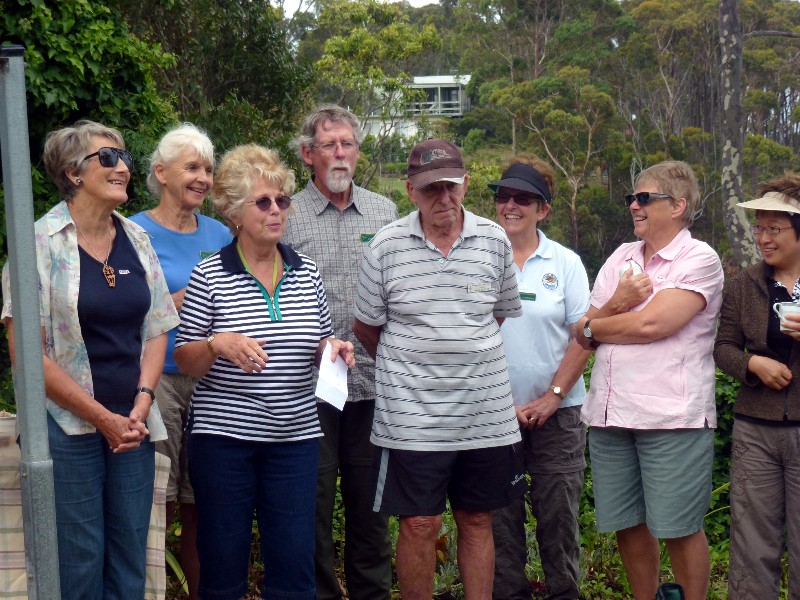 |
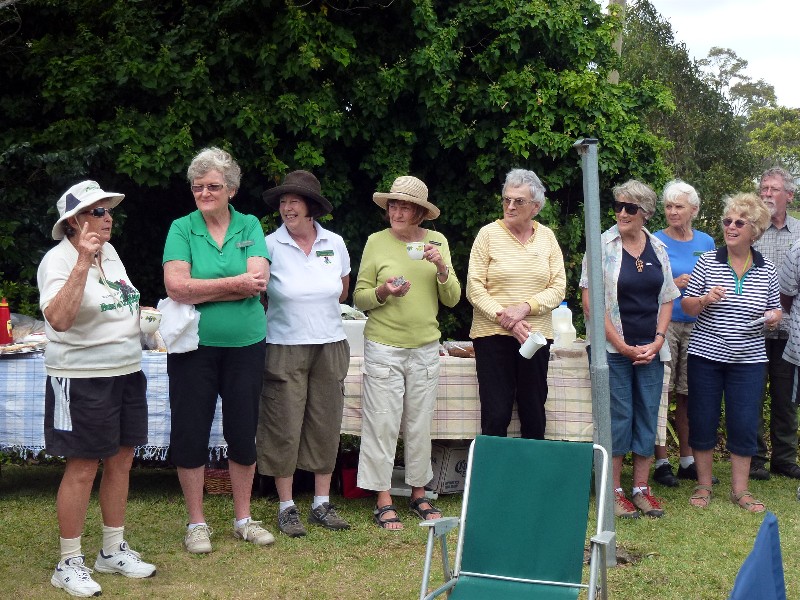 |
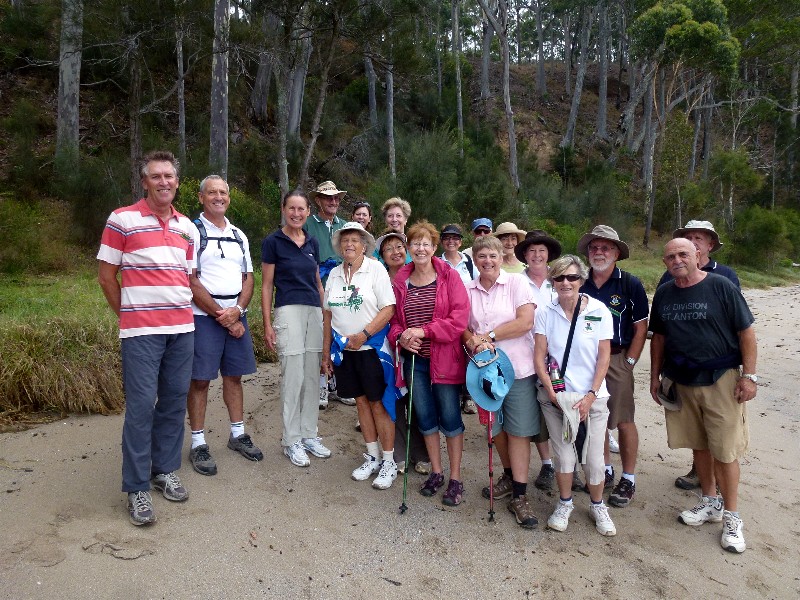 |
Host Lyn entertains the troops
Photo by Lesley
Click on thumbnail to enlarge photo |
Ainslie makes a point
Photo by Lesley
Click on thumbnail to enlarge photo |
One of the walk groups on the beach
Photo by Lesley
Click on thumbnail to enlarge photo |
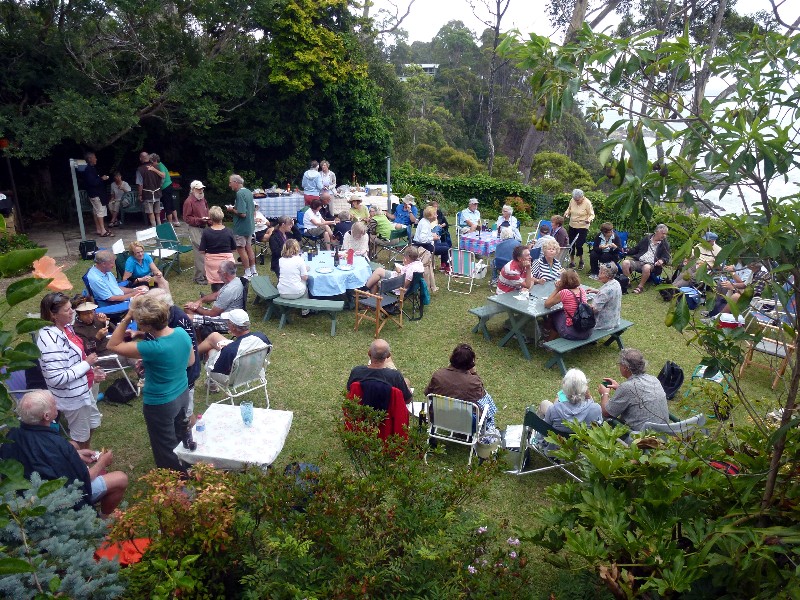 |
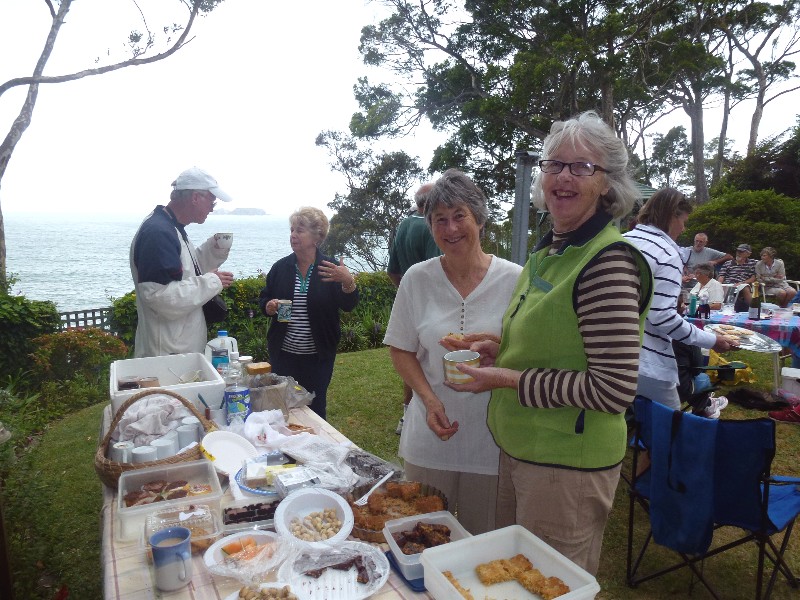 |
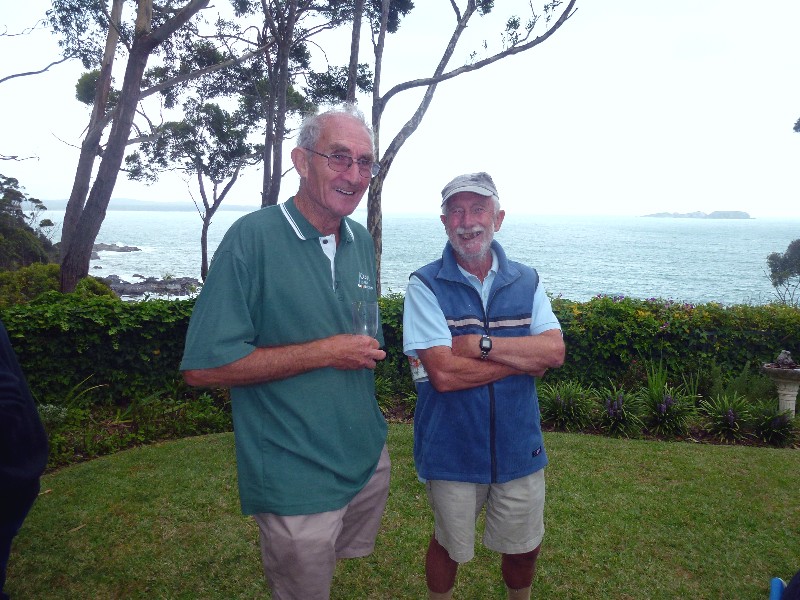 |
Apres walk sausage sizzle
Photo by Lesley
Click on thumbnail to enlarge photo |
Mary, Jean and a groaning goodies table
Photo by Lesley
Click on thumbnail to enlarge photo |
Mike and Ron
Photo by Lesley
Click on thumbnail to enlarge photo |
back to Top
